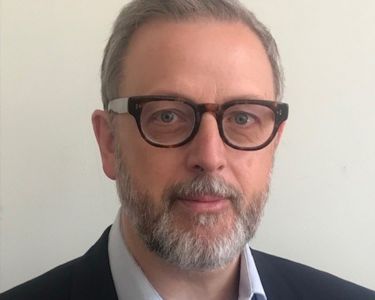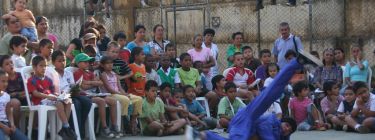
The cocktail of challenges of disadvantaged in crisis
Ruth Daniel, CEO of In Place of War and Honorary Research Fellow at University of Manchester; Teresa Ó Brádaigh Bean, Leader of research activities at In Place of War and Honorary Research Fellow at University of Manchester
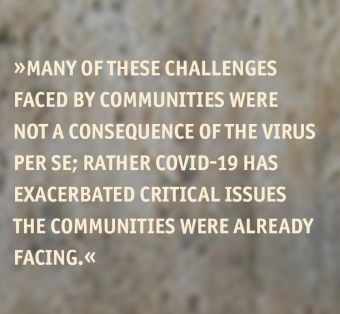
The cocktail of challenges of disadvantaged in crisis
Making the case for the civic role of the creative and cultural ecosystem in a Renaissance
The ongoing COVID-19 Pandemic has had a devastating impact on communities around the world. Whilst in Europe many have enjoyed the cushion of working from home or social protection mechanisms (special benefits and unemployment protection), disadvantaged communities in Latin America, Africa and the Middle East have been left vulnerable on all fronts. Operating in mainly the informal economy or in precarious employment, living in overcrowded housing, lacking access to information or PPE (personal protective equipment), and enduring some of the strictest and militarised lockdowns in the world presented these communities with a cocktail of challenges. This piece builds on the work of In Place of War in sites of conflict in the Global South for over 17 years working with grassroots arts-based peace-building as well as 120 cultural leaders and gives witness to the role of community arts organisations in civic engagement, using the arts to mobilise communities to make positive social change.
Picture above: break dance performance in a sports ground, Medellin, Colombia. Copyright: Leonardo Jimenez
COVID-19 was a further catalyst for community arts-based social mobilisation and civic engagement to tackle immediate issues of food insecurity, lack of sanitation, wellbeing, and public health awareness and school closures. Many of these challenges faced by communities were not a consequence of the virus per se; rather COVID-19 has exacerbated critical issues the communities were already facing. Working in partnership with our network of change-makers, drawing on their local knowledge, existing community relationships and understanding of how best to respond to the pandemic, we supported them in delivering direct, bespoke assistance, determined and led by those located in beneficiary communities. These locally-led processes resulted in a range of responses from the creation of community kitchens to mobile sound systems and online fundraisers and concerts to provide economic assistance to artists and the wider communities. Despite the array of projects, they all reaffirmed our understanding that art can be key in fomenting civic participation and positive societal change.
Despite or because of COVID-19: a new role for social enterprises
This process also demonstrated how, with a small amount of funding, informal, grassroots organis-tions rooted in communities that are often underrepresented in the cultural sector and who can’t normally access funding can lead to long-term positive outcomes. This included the development of sustainable social enterprises. Thus, this invites reflections in the European context and beyond about the importance of embedding participatory grant-making for grassroots arts organisations as a strategy to create a more inclusive and diverse creative ecosystem that supports arts-based sustainable development.
Hunger isn’t in Lockdown: COVID-19 in the Global South
As COVID spread, and lockdowns were imposed globally, our network of change-makers provided grim insights into the impact of COVID-19 on some of the world’s most disadvantaged communities. Here is a snapshot from artists and cultural practitioners on the ground in Latin America, Africa and Asia in April 2020.
MC Benny, Hip Hop artist, Northern Uganda: “People are living in fear, many are testifying that this is worse than a physical war. Our team has already seen that government forces have been using excessive force to enforce lockdowns”
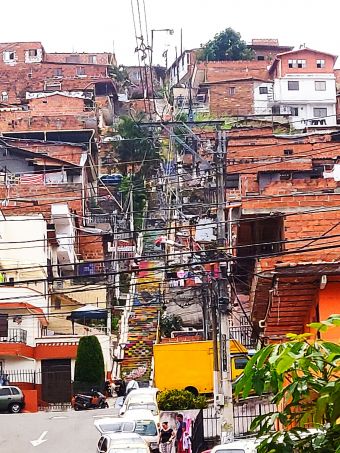
Nathalia Garcia, Elemento Illegal, Medellin, Colombia: “Communities in El Faro, an informal neighbourhood on the outskirts of Medellin where many displaced families forced to flee violence have been severely affected by COVID. The area is home to 400 vulnerable families living in dire conditions, working in informal and precariousemployment. Lockdown has left them unable to generate income and 98% of them are struggling to cover their basic needs with hunger being the most pressing issue. Preventing the spread of COVID in the area is further compounded by lack of basic sanitation and hygiene products.”
Vijay Kumar, India: “There is simply no support from the government, some families are on edge of starvation during these days.” Our team notes, “India has some of the most extremely high-density urban populations, social distancing is simply not an option for most of these people, and the consequences of lockdown are costing lives through hunger and lack of medicine.”
Robert Mukunu, Mau Mau Arts, Kenya: “A young boy was shot by police on the balcony of his home in Kiamaiko, Nairobi, because ‘he was out during the curfew’ which seems like a dark irony that a citizen was killed by police who were ensuring he was indoors to protect him from COVID. Questions still remain unanswered on why the government is charging for treatment of corona-related ailments as well as the use of testing kits and masks donated to the government.”
Re-birth in the midst of lock down? How to leverage support and funding from the Music Industry in crisis conditions
Whilst IPOW’s work has focused on supporting and building networks with grassroots artists in the Global South, the organisation has also developed relationships with commercial music industry partners. During the pandemic, given the devastating impact of COVID on the cultural sector, these organisations were keen to support artists and cultural practitioners. Thus, working in partnership with In Place of War, small grants of $500 to $2,000 were made available to the change-maker network.
Setting up an innovative process for participatory grant-making, locally informed decision-making and implementation.
A call for applications was sent to our change-maker network via Whatsapp in French, English and Spanish, resulting in 45 applications. The application process was open in which applicants had to explain the impact of COVID on their community and their ideas to address these issues. A small panel from the In Place of War Board and team reviewed applications, selected recipients, and funds were distributed promptly, having immediate impact. The overall process took only two weeks, including the due diligence process required to meet charity regulations. Given the geographical spread and diverse contexts in which artists operate, projects ranged from tackling food insecurity through the establishment of community kitchens, bakeries and allotments, public awareness campaigns about preventing the spread of COVID-19 using visual arts, and issuing grants to artists.
Change-Maker case studies
Delhi, India
Vijay Maitri is a theatre practitioner from the Kathputli Colony in Delhi, India.
Due to lockdown, this community of 12,000 performing artists (the lowest caste in India, considered to be the criminal caste) who live in slum conditions, were unable to earn money and therefore unable to afford any food or access PPE.
Vijay organised a food and PPE distribution centre in the neighbourhood and using the IPOW grant distributed food and PPE to 12,000 people.
Picture right: Vijay organising food distributions, Copyright: Vijay Kumar
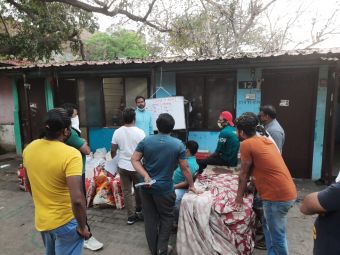
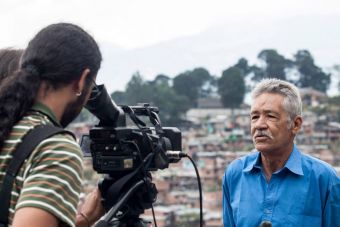
Medellin, Colombia
Alejandro Rodriguez is an MC and music producer and part of Old Guns, a hip hop collective from Comuna 13 in Medellin, Colombia.
Comuna 13 is a disadvantaged neighbourhood suffering from high levels of poverty and violent gangs. During the lockdown many residents could not make a living as they work in the informal economy as street vendors, builders, collecting rubbish and recycling. Thus, lockdown left them struggling to access food and essentials.
Picture left: Ciudad Comuna interview, Copyright: Ciudad Comuna
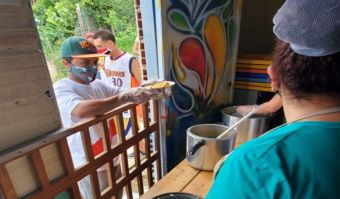
With the In Place of War grant, Old Guns decided to develop a community kitchen and allotment to address the issue of food insecurity in the area. They secured a building, partnered with a local community organisation, got permission from the gang leader who controls the area and enlisted an army of volunteers to work in the kitchen. During lockdown, the kitchen served 750 meals a week to vulnerable members of the community using produce from the community allotment.
Picture left: Kitchen serving meals during lockdown, Copyright: Alejandro Rodriguez
Caracas, Venezuela
Tiuna El Fuerte is an arts organisation located in El Valle, Caracas, Venezuela.
People living in tower blocks in the surrounding neighbourhood felt isolated and disconnected during lockdown, resulting in a decline in mental health.
Using the grant from In Place of War, Tiuna El Fuerte set up a mobile sound system and radio station, which travelled across the streets playing music and sharing messages over the sound system from loved ones across the community, helping people feel less isolated. They estimated that they reached over 20,000 people in two weeks.
Picture right: Tiuna El Fuerte’s Radio Verdura in the streets of Caracas, May 2020. Copyright: Tiuna El Fuerte
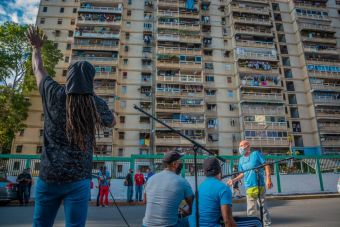
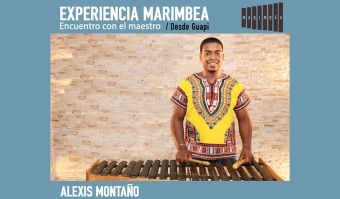
Cali, Colombia.
Marimbea is a cultural organisation based on the Pacific coast that works to promote Afro-Colombian culture through tours, performances and workshops. Due to the pandemic and lockdown, the community were unable to work and lacked access to basics. Using a grant of $1,000, Marimbea organised a series of online events, performances and workshops, paying the artists to participate and charging audiences to engage with the content. The events generated $2,000 in revenue and led to the development of a new digital content platform offering cultural experiences online.
Picture left: Promotion material for online workshop, Copyright: Marimbea
Reflections: What to learn for the idea of a Renaissance
These case studies provide interesting insights into the civic role of arts organisations in mobilising to address critical needs of local communities during the pandemic. This is hinged on a number of features. These organisations are committed to a place; often taking place in public spaces such as playgrounds, community centres, parks and schools, it is part of and shapes the local landscape. It is rooted in and part of their communities and thus artistic practice is designed by and for those communities. Given this, the art responds to the needs and aspirations of this community, and nurtures and celebrates the talent within the community.
Civic participation and artistic practice can not be divorced
This is a people-centric and local approach using artistic practice to facilitate human development, promoting positive values and social interaction and building communities. Given this, civic participation and artistic practice cannot be divorced: they are enmeshed and develop a symbiotic relationship. Art is a tool to engage communities which through participation leads to new artistic work and a more inclusive and diverse creative ecosystem designed to develop the community.
Indeed, one of the commonalities between these responses to the lockdown was that the organisations improved their standing within their local communities. Their work during the pandemic has elevated their status and visibility within the community and beyond. The creation of Trackside’s bakery and Marimbea’s digital cultural experiences are representative cases of this.
Picture right: Theatre performance about disability in Northern Uganda, Copyright: Mono Grande
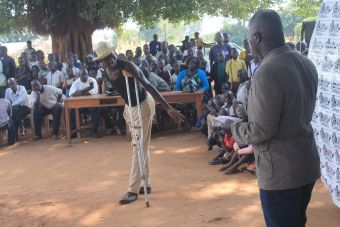
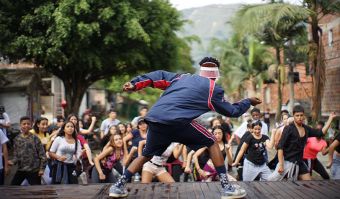
Radically nurturing artistic talents—and their aspirational community
We believe that, as in the case of our change-maker network, identifying and nurturing existing talent and projects in communities is key in developing genuine arts projects that respond and evolve to meet the needs and aspirations of the local community. Thus, rather than prescribing themes and agendas, offering support for the evolution of organic arts based community is of paramount importance.
Picture left: Dance class in Medellin Credit_Mono Grande, Copyright: Mono grande
Be innovative about funding social innovation
Similarly, developing more inclusive and open funding streams to enable grassroots, informal organisations to access funds to create civic arts projects is also key. We adopted a participatory grant-making model that allowed art organisations to develop responses that were tailored to their experiences and knowledge of their communities. They were not constrained by our preconceptions of what was the most critical need and this is clearly reflected in the range of responses the organisations developed. Small grants were distributed to informal groups and collectives as well as local NGOs which we were able to award without the need for clumsy and prohibitive due diligence processes, whilst crucially complying with charity commission regulations. Thus, in sum, the pandemic has illuminated the primordial role that local grassroots arts organisations can play in addressing critical issues facing communities, especially in times of crisis. They can be responsive and resourceful, generating immediate and real impact with little funding. This therefore invites us to rethink how we understand community arts projects beyond short-term interventions that respond to fleeting policy agendas and political strategies.
How can the cultural and creative sector foment grassroots, locally-led civic arts that showcase and celebrate talent in towns and cities in Europe both during and beyond the pandemic? How can we create inclusive and accessible funding processes so that such informal groups can develop and sustain their practice whilst generating long-term positive outcomes?
The creation of diverse networks and long-term relationship-building connecting commercial partners, governments, formal cultural institutions and grassroots collectives is key to fostering long-term arts-based social transformation in our communities—a transformation the green and digital transformations cannot do without—like, for example, the New European Bauhaus, the latest initiative of EU President von der Leyen highlights. Learning from the Global South how to empower arts-based social transformation in communities might strengthen a Next Renaissance in Europe while preventing one of its major risks: Of being a Revolution for the Privileged.
Links
Creativity Conquers COVID- A short documentary about the how IPOW’s change maker network responded to the COVID lockdown
Ruth Daniel
Ruth is a multi-award winning CEO, activist and change-maker. Inspired by the transformative use of hip-hop in the drug cartels of Medellin, Colombia, when a young MC said: ‘If it wasn’t for hip-hop, I would be dead. Hip-hop gave me another option and I’m truly thankful for that.’ Ruth believes art has a capacity to make change in the toughest of contex From guitarist at the age of 8 to record label owner, band manager, fundraiser, international cultural activist, entrepreneur, educator, influential speaker (TEDx) to prestigious award winner within a national arena (Social Enterprise of the Year & Manchester Woman of Culture to name a couple), Ruth’s passion to empower people to build their own positive futures through creative entrepreneur programmes, the development of cultural spaces and artistic collaboration shows no boundaries in terms of fields of work.
Picture © Katie Dervin
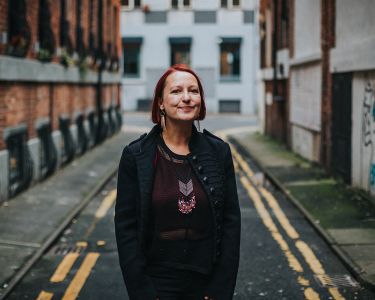
Teresa Ó Brádaigh Bean
Teresa Ó Brádaigh Bean is head of research and learning at In Place of War, a global charity that works to support grassroots arts based social change processes in sites of conflict. Her research interest and practice has focused on hip hop as a social movement, grassroots arts education, creative entrepreneurship in sites of conflict and community arts based peacebuilding. She has undertaken a number of research project exploring arts based social change processes mostly recently as a researcher on the the Art of Peace led by Prof. Oliver Richmond at the University of Manchester. She has played a key role in developing In Place of War’s education programmes. As a qualified teacher, she wrote CASE (Creative and Social Entrepreneur Programme). CASE was one of the five shortlisted finalists for the inaugural UNESCO-Bangladesh Bangabandhu Sheikh Mujibur Rahman Creative Economy Prize in 2021. It was awarded the Outstanding Contribution to Widening Participation at the University of Manchester’s Making aDifference Awards in 2017. The programme has been delivered in 14 countries including Bosnia, Uganda, Colombia, South Africa and the MENA. Teresa is an Honorary Research Fellow at the University of Manchester and a member of the Global Coalition on Youth, Peace and Security (GCYPS) a UN Inter-Agency Network.
Picture © Alexander Butcher
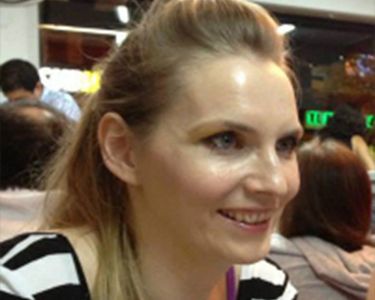
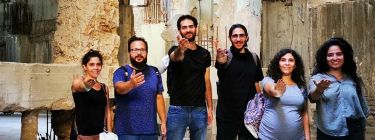
Is the show bigger than the art?
Director of theatre-based NGO Laban, Beirut
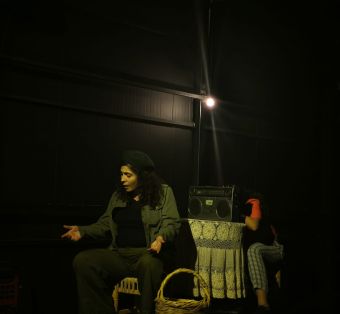
Is the show bigger than the art?
Producing Arts in times of revolution: Learnings from 30 years of Lebanon crisis about what artists might do and for whom in Renaissance
On 17 October 2019 in Beirut, Lebanon, I played the role of a dead fighter from the Lebanese civil war (13 April 1975- 13 October 1990). Twenty-nine years after the ceasefire in Lebanon, the civil war was still alive in the minds of the Lebanese. This open wound remains bleeding with thousands of missing, thousands of dead. The country proceeded with no reconciliation, no accountability, ruled by the same militia leaders and their customers until today. I call them customers as they are nowhere close to citizens: they live by and for the leader or political party, standing in the way of every possibility of change. Their relationship with the system is based on benefits to themselves, not rights and duties.
Picture above: Farah Wardani among several team members at the opera house that the people reclaimed during the revolution, Copyright: Laban
Picture left: Farah Wardani performing at one performance on the night of the revolution, Copyright: Laban
Malja’86 (Shelter’86) is a play based on stories of personal objects, all of which witnessed and survived the Lebanese civil war and were inherited by the subsequent generations. The objects are residues of a memory lost to the generation that experienced the war and the generations carrying the traumatic experiences of the past. This piece follows the story of Sami, who enters the memory of his grandmother, trying to look for his father. Inside her memory, he meets different characters from the past who might guide him—through their own memories and stories—to the truth about his father’s disappearance. On the opening night in Laban Studio, as I played Layla, the ex-fighter that lives in the memory of Sami’s grandmother, during a scene of a demonstration, I heard people chanting Thawra (revolution in Arabic). I felt immersed in the role; I had goosebumps all over my body. I felt a connection with my community, with this never-ending war, whose inherited trauma I hold in my psyche like every other Lebanese. After the show was over, I realised that thousands of people were marching the street right below our rooftop studio, on Spears Street, heading towards downtown Beirut, to announce the people’s revolution. I took a video on my phone and I knew this was the beginning of something huge.
Mlaja’86 opened that Thursday night and was expected to play until Sunday. However, the revolution took over the country and all activities were stopped to join the people on the ground. We, as Laban Studio, announced on our Facebook page, „In a matter of such national importance and duty, Laban is joining the civil protests in Martyr’s Square. Join us to raise our voice for the people and against the oppression. See you there!“
That was the right place for Laban and me as the director of this organisation.
On the streets, a woman approached my colleagues and me after we entered the Opera House of Beirut. The Opera House had been closed since the civil war. It was still closed as the same warlords wanted to demolish it and transform it into a hotel, or a personal business, erasing our culture as they did with several other cultural monuments. The revolting people took over several sites closed since the civil war in the heart of Beirut. The woman came and said, „You are the playback people. I thank you for this,“ with a hand gesture that contained the entire city, the country, the revolution.
We stood in awe and humbleness. ”Us? Why?“ my colleague asked.
She responded, „Your theatre taught us that we have a story worth sharing, we have a voice that we must use, and here we are writing our story, raising our voice, thank you!“ and she moved away on her bike. Yes, her bike. Quite unusual for Beirut. Here people only move in cars and buses. The city isn’t bike-friendly, it isn’t walking-friendly, it’s barely human-friendly. For a European reader, a bike in a public space is typical, if not the norm. No wonder that as we ask for fundamental human rights—Europe is on a carbon-free EU revolution.
The question here was, how do we do arts in the middle of all the beauty on the streets? Our safe space that was the closest thing to a public space, to a community that a Lebanese would dream of, was now too small in comparison to the streets and squares of the country, filled with citizens taking over the abandoned spaces and declaring them public, cultural, and collective.
Picture right: Poster for Malja’86 (Shelter 86) play, Copyright: Laban
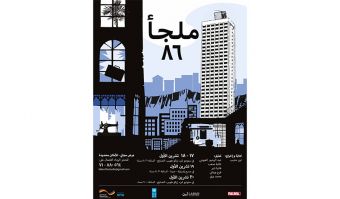
The revolution produced street art, social and political art, graffiti, songs, dancing circles, and discussions. Movies were made and spread across the world from mobile phones, and every chant was a masterpiece, every slash on a wall was a mural, every conversation was an improvised piece of art. What do we have to offer meanwhile? My team of 25 young people, Laban, is a theatre-based organisation, working since 2009 in Lebanon to create safe spaces of expression. After hours and hours of discussions, the team members met and decided that no art can contain the moment and taking our art forms into the street is a selfish act: Our work will be climbing over the revolution’s shoulders and will add nothing to it.
We decided to join our people. We took to the streets for months, experienced tear gas, rubber bullets, were assaulted by police thugs, got arrested, protested, shouted, chanted, danced, talked, and put our hearts, bodies, and intellect into this revolution as we do with our art. It was a collective masterpiece in the making. Meanwhile, the conversation didn’t stop: What do we do with our art? We are artists, and this is what we do for a living, to provide for our families, to survive.
„The one who opens something knows well how to contain it.” This wisdom came from a friend of the organisation. Let us perform our art to contain the individuals, not the community. In our playback, we always take the story shared by an individual, an audience member, to the communal level. We tackle the political in personal stories. Now we switched the game, now is the time to tackle the personal in all this political happening.
We had our first monthly performance around four weeks after the revolution started. People came in, a lot less than usual. The streets had all the eyes and light on them. We had our space opened for those who wanted to go small in the middle of the big act. Four weeks and violence was already happening, hidden agendas were surfacing, and the rhetoric of treachery was all over the mainstream media. The stories that emerged were, directly and indirectly, reflecting the fear of the people: how Lebanese people saw a glimpse of hope, an unusual hope. And now they were afraid of believing and losing, they weren’t ready for another grief, another loss, they weren’t prepared to be put down, again and again. Nothing as big as this revolution had ever happened in Lebanon, but it was the accumulation of the
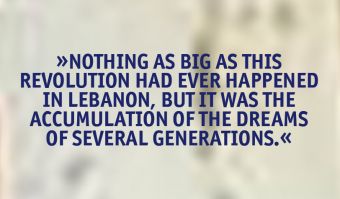
dreams of several generations. The stories were communal and political, but we focused on the personal. We listened profoundly and touched on the sharing’s most resounding note, and it was reflected on stage. Our stage served as a margin to the revolution.
Our art form is minimal and intimate. For several nights, I wished we did drum circles, street art, dabkeh dance, or any art form that could be transformed into jam sessions and that the masses could join in immediately so that we could go on the streets and engage with the people. I saw other artists taking their music, clowning, and dancing into the streets but what was happening was bigger than any framed artwork, from any rehearsed acts.
I was six months pregnant with my second child, and my first was four years old. We were on the street of Al Azariyeh, where six clowns were jumping and connecting with the people. A finance expert had some people gathered around him talking about the financial crisis.My son had his eyes all on the finance expert, totally ignoring the clowns, and when the man finished his explanation, my son started clapping hard. Unintentionally, the man had put on a show, he had stolen the spotlight from the clowns and everyone else. He had the charisma, the presence, the passion, and the devotion—all the factors you need to grab the attention of the young and the old. The clowns proved the theory that when the show is bigger than your art, you should make way for things to happen at their own pace. Your time will come.
Farah Wardani
Farah Wardani is a theatre actress, trainer, clown doctor, puppeteer and applied theatre practitioner.A theatre graduate with a DipHE, a BA in psychology, currently finishing her MA in Drama Therapy.
Farah is the director of Laban (a Lebanese theatre based NGO). A Playback Theatre practitioner, trainer, actress, conductor and faculty member of the ASPT, she leads drama therapy workshops with Intisar Foundation targeting Arab women victim of war.
Farah trains and uses Theatre of the Oppressed, Drama Therapy and other techniques with different communities and contexts as a medium for healing, social change and political activism.
Picture © Mohsen Al Zaher for Laban
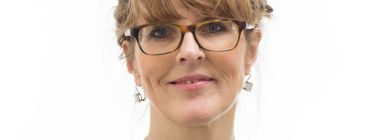
Climate and Culture united in crisis – or in the Next Renaissance?
Director of Julie´s Bicycle, London
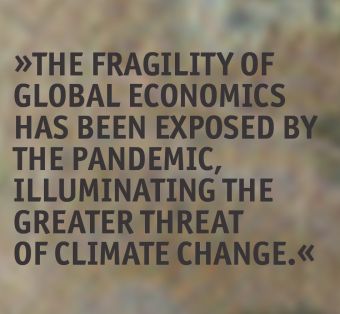
Climate and Culture united in crisis – or in the Next Renaissance?
The Green and The Game changer
The COP26 global climate talks failed to commit to global temperature limits of 1.5 degrees warming, or to establish financial mechanisms to ensure climate justice is given the attention it richly deserves. Global climate governance has not yet succeeded in building consensus for rapid action in spite of the Paris Agreement.7 Perhaps the real challenge is found in root metaphors and their narratives—nature as machine, hostile, to extract, improve, sell, or sentimentalise. The story of climate change is in the buried histories of human and nature conquest, anchored in cultural values of human supremacy. The climate crisis as a cultural crisis, the consequence of myths and stories that permeate society in profoundly subtle ways.
The fragility of global economics has been exposed by the pandemic, illuminating the greater threat of climate change. Ambition to take action has surged across communities and business—the sheer volume of net zero commitments has potential to profoundly change our world —though only if the pendulum swings away from offsetting to absolute greenhouse gas reductions, especially in wealthy economies. And COP26 has bolstered net-zero targets by tightening governance for
carbon trading rules. Up until now cultural policy has, by and large, been oblivious to the encroaching climate crisis, rarely invoking ‘externalities’ from nature (i.e. clean air, green space, carbon profiles), or cultural rights, safety and social inclusion, profoundly affected by environmental conditions. This is true at every level, though city policy is more progressive than national policy, as are smaller institutional commitments. New ambition in the cultural sector is creating conditions for good climate governance.
The arts, like any other sector, have an ecological footprint and Julie’s Bicycle (JB), founded in 2007, began with a focus on the sector’s impacts, and ways to work within the ecological constraints of our planet. Unleashing the energy of the creative community and championing values that restore our sense of belonging within nature, was the real objective. Beyond the arts, the potential of the
creative industries to influence change—design, advertising, film, media, fashion—is huge. JB, which specialises in the arts, has translated the climate crisis into everyday currency with sector-specific expertise and resources that inspire words and action. Our premise is that doing empowers the arts to champion ambitious climate action across civil society. Working closely with the UK music industry, JB generated a methodology for greenhouse gas emissions analysis, carbon calculators for creative activities (buildings, tours, festivals, productions) that are used across the globe (5,000 current users of which about 2,000 are international).
Over the last decade, Julie’s Bicycle has expanded into performing and visual arts and museums, blending cultural and scientific knowledge for cultural practice to serve the planet.
Culture as an ecosystem: Arts Council England
Culture, just like any other sector, is an ecosystem: changes to one part are felt by all. Climate action needs to be tackled eco-systemically, including changes to policy and investment to align international frameworks. These goals are clear: net-zero carbon, green economy and climate justice. In 2012, Arts Council England (distributing £507million in 2019/20) embarked on the largest environmental literacy programme for culture anywhere in the world, making environmental requirements a funding condition. The backdrop was a bigger policy moment: the 2008 UK Climate Change Act. All Arts Council’s National Portfolio organisations (some 828 receiving core funds over multiple years) were asked to measure environmental impacts using JB’s Creative Green tools and have a policy and action plan. The data collection and policies formed a small part of a rich programme of research, resource development and knowledge-sharing evaluated annually. JB was initially
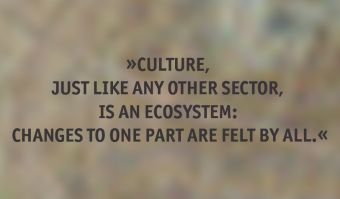
contracted for three years; by the time we complete the current contract (2023) the programme will be over a decade old. Results show an annual 4.5% reduction in energy use across 1,200 organisations, equivalent to over £16million in energy savings, with improved wellbeing and creative inspiration. Over time the partnership has got more demanding; 2018-2022 outputs include setting science-based targets for Arts Council’s largest energy users, 30 major institutions comprising 80 sites, which collectively reduced emissions by 18% in 2019-20.
A decade of data-gathering and collective cultural learning has generated credible and robust evidence, which makes a good case for scaling action. Starting from the basics—carbon footprints—the Arts Council’s deceptively simple policy is demonstrating how a sustainable cultural sector might work.
This vital perspective on culture, seen through the lens of our environment, has stimulated debate and passion, and catalysed a dialogue about the purpose of the arts more widely.
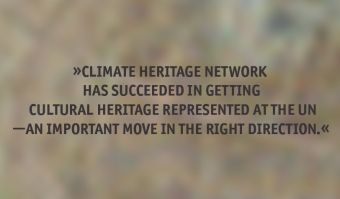
The International Perspective
Arts Council England’s intervention is only one, albeit effective, approach. Scotland and Wales, devolved nations with their own funding bodies, have established inspiring programmesthat combine accountability with exciting creative content. However, internationally, there is an urgent need to build environment into national arts policies. JB’s 2014 research partnership with the International Federation of Arts Council and Culture Agencies (IFACCA) recommended that national cultural policies explicitly reference environmental sustainability and build a global network to exchange ideas and resources with regional centres of excellence. The arts are hampered by a lack of data to underpin cultural policy, a gap which also prevents cultural activists from leading solutions and influencing major climate decision-makers. Climate Heritage Network has succeeded in getting cultural heritage represented at the UN—an important move in the right direction. In 2017, frustrated at the glacial pace of policy change, JB and World Cities Culture Forum, a network of global cities, developed a project for culture leads to connect to their environment counterparts in government and align goals. In many cities climate action is much more ambitious than national ambitions but there is patchy read-across of national cultural policies at this level, notwithstanding some inspirational examples.
Where are we now?
In the 6 months preceding COP 26 JB returned to national policy to understand progress aligning national culture policy with the Paris Agreement, as part of the British Council’s Climate Connection. Desk-based research, a survey to about 200 ministries, interviews and in-depth roundtables in Turkey, Indonesia, Nigeria, the UK, and Colombia, explored policy commitments and trends.We found that…
1. In spite of the Paris Agreement, requirements for climate action are still rare in national cultural policy. In the main, priorities are not yet reading explicitly across commitments to achieving global net-zero greenhouse gas emissions nor to environmental discourse on justice and just transition. There are some outstanding exceptions, notably Argentina where cultural policy reads explicitly across the national climate policy.
2. Many of the priorities of national cultural policies are environmental issues, especially relating to justice but framing and terminology does not, in the main, illuminate the commonalities. Cultural rights are often connected with environmental justice, and arts for transformation is connected with ‘just transition’. Translating cultural priorities into the vernacular of environmental policy and enriching environmental policy with cultural perspectives is a good starting point.
3. Broad sustainability issues are well represented in national cultural policy, especially as regards heritage, cultural rights and sustainable development. Connections to climate and environmental issues are often implicit. Policy dialogue with local and creative practitioners working from the ground up is urgently needed.
4. The huge potential of culture and creativity is not being leveraged systematically to address environmental issues in governance, i.e. to protect and preserve culture and heritage; to create safe places and strengthen and celebrate communities, circular design, new material use, innovative urban and city partnerships, new businesses, ideas and skills.
Art gives us different ways of knowing, and culture emerges from our many different ways of being; too often it feels like the creative community is showing up in spite of the lack of a presice place of action. While politics is debated in official halls, we work in the spaces between—sometimes being outside the system is exactly what’s needed. But what if we re-imagine a COP process shaped instead around culture?
The dominant cultural narratives must change and culture and creative endeavour should orient to this new purpose. The cultural sector—the arts, creative industries and heritage—can make a crucial
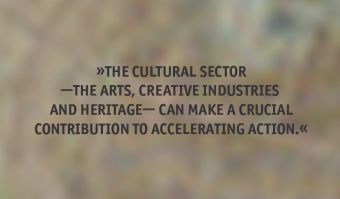
contribution to accelerating action. Culture is vital to national economies, contributing creative skills and innovation, and influencing lifestyles, tastes and consumption. But, most powerfully, art can change hearts and minds and it is intimately connected to place and to community. Artists can move us to reimagine our world and inspire societies to take climate action and contribute their best to the Next Renaissance.
Alison Tickell
Alison Tickell established Julie’s Bicycle in 2007 as a non-profit dedicated to mobilising action on the climate crisis, initially in the music industry and now across the arts internationally. Originally trained as a cellist, Alison worked with jazz improviser and teacher John Stevens, and community activist Dave O’Donnell at Community Music rethinking music education: what it’s for, what it values and who thrives, before setting up Julie’s Bicycle. She has also had many other roles (voluntary and paid).
Alison is an Ashoka Fellow.
Picture © James Allan
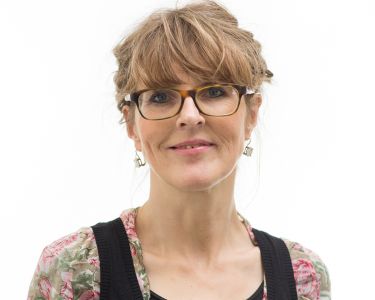
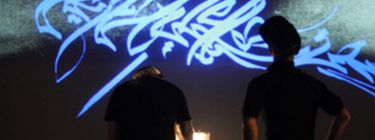
Connecting people and places
Susa Pop, co-founding director of Public Art Lab and Connecting Cities Network; Martijn de Waal, professor at the research group Civic Interaction Design at Amsterdam University of Applied Sciences, Berlin
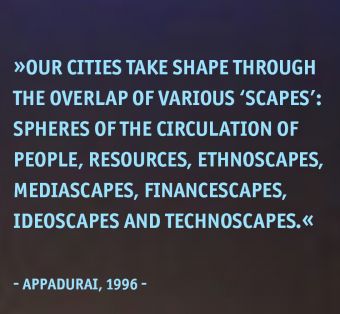
Connecting people and places
Why Cultural Led Urban Developments are necessary for Resilient Cities
Placemaking is a global civic trend in urbanism. However, a novel combination of arts, technology development and processes of urban governance empowers placemaking to be responsive and forms an essential contribution to a next renaissance of global cities. Not necessarily by making them less global as the following case studies show, but by bringing in a perspective of interconnected local publics and public values to urban policy, from the design of public spaces to the organisation of urban resource management and carbon-neutral cities.
Picture above: Digital Calligraffiti 2017-21 commissioned by Public Art Lab in cooperation with the artists Michael Ang, Don Karl and Hamza Abu Ayyash, Copyright by Michael Ang and Public Art Lab
Responsive Placemaking
Our cities take shape through the overlap of various ‘scapes’: spheres of the circulation of people, resources, ethnoscapes, mediascapes, financescapes, ideoscapes and technoscapes.1 The rise of new technologies and their accompanying practices in the past quarter of a century—from budget airlines to the internet—has intensified the flows in these various scapes and between them. Today we witness interlinked geographies of these scapes across the globe, making the world’s cities ever more interconnected. Hence, from the mid-1990s onwards, scientists, policy makers and mayors around the world increasingly started to think of our cities as part of networks of global cities, immersed in a space of flows, facilitating a worldwide creative class. However, as has become clear, these global cities did not only produce economic growth and innovations—from tech to finance—but also huge inequalities, both between and within cities, both economically and in terms of cultural and political equity.
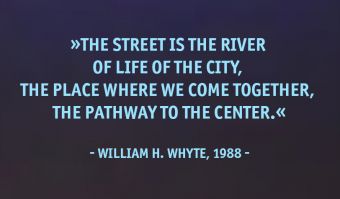
To address the tensions and inequalities that have arisen from the emergence of global cities, new approaches are needed that combine top-down urban policy with bottom-up ‘citymaking’ and centre around public values. Such an approach should not so much deny the interconnectedness of cities, the rise of digital networks, or the dynamic interaction between the various scapes. Rather, these should be embraced from a different perspective: a perspective that foregrounds civic relations and public values. In the past decade or so, digital and responsive placemaking has emerged as an approach that does exactly that. Digital and responsive placemakers understand our cities as ‘hybrid spaces’, simultaneously produced by their physical design as well as through their manifestations in virtual networks. The experience of a city is not just that of its buildings and monuments, its materialised institutions like city halls and local libraries and locally embedded cultural practices from weekly markets to critical mass bike rides. Increasingly, the ways in which the city is made up also include mediated versions of these experiences, through urban sensor data, social network practices and the search algorithms of digital map services, all reinforcing each other.
Responsive placemaking integrates this perspective with former ideas about placemaking that go back to Jane Jacobs and William W. Whyte and their groundbreaking visions and methodologies in the field of urban planning and architecture of the 1960s and 1970s. Revolutionary for their time, they brought out the importance of the seemingly trivial practices and rituals of everyday life for the success of cities, focussing on the street as a site in which social relations, trust and urban society could take shape. “The street is the river of life of the city, the place where we come together, the pathway to the center.”2
Responsive placemaking enhances such a perspective with new modes of representing and experiencing the city and the built environment and, more generally, time and space.
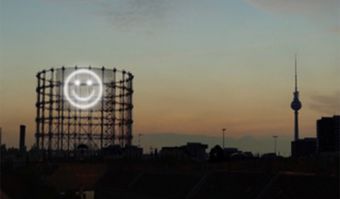
Picture above: Public Face I @Mood Gasometer, Berlin Schoeneberg, comissioned by Public Art Lab for the Media Facades Festival, Copyright by Julius von Bismarck and Public Art Lab
New Practices
Responsive placemaking can take various forms, and we’d like to highlight three of these here as examples of projects in which we have been involved ourselves.First, through projects of representation, responsive placemaking highlights the connections between people and places, and contributes to the construction of local publics. They can aid bringing out a ‘sense of place’ as well as a layered, variegated ‘sense of us’.
Second, as collaborative management and governance, responsive placemaking aims at providing these local publics with tools to organise themselves as collectives, addressing civic engagement and social inclusion. It seeks to set up alliances and coalitions of citizens, government representatives and professionals to organise around issues of communal concern, and the collaborative and inclusive management of local resources, from reusable energy communities to commons-based housing cooperatives.
And third, illustrating practices of translocal exchange and mutual learning, responsive placemaking does not approach local initiatives as isolated communities, set in their own time and place. Through the various scapes they are often part of various translocal movements and communities that enable mutual learning.
New Relevance of Translocal Communities and Mutual Learning
As such, in times of global pandemic, responsive placemaking becomes relevant in the context of border closures, spatial isolation, loss of mobility within and between cities, social distancing and quarantine measures. Although the pandemic has had devastating effects for individuals and societies globally, it is also an opportunity to rethink the ways we engage in intercultural dialogue and responsive placemaking in sustainable and equitable formats. As stated by Michele Acuto, director of Connected Cities Lab and professor of global urban politics in the School of Design at the University of Melbourne, “empowerment and community-building need to be at the heart of the digital lessons we are learning from COVID-19.“3 Although we are not travelling, we must work to understand better new types of transnational mobility. According to Federico Parolotto, in post-pandemic landscapes, hyper-mobility may be less feasible and therefore “digital connectivity will emerge as the most prominent transport technologies.”4 Although we are social beings, and most of us crave physical connectedness with others, the pandemic has revealed that we can and must continue to develop effective, inclusive and meaningful ways to connect digitally—novel forms of mobility.
Public Face: How does Berlin feel today?
Public Face5 is a showcase of responsive placemaking contributing to the representation of publics. It transformed a gigantic screen at the Gasometer in Berlin Schoeneberg into a ‘Mood Gasometer’ representing the emotions of the citizens in Berlin. It was developed for the Media Facades Festival6 in 2010 as a realtime data visualisation. The artist team Julius von Bismarck, Benjamin Maus and Richard Wilhelmer recorded and filtered the faces of the citizens with the newly developed software of facial recognition and transmitted the data of the dominating emotions of the group in the form of a emoji in real time on the big screen of the Gasometer with the question, „How does Berlin feel today?” By gathering data in public space, and by scraping social networks, these installations display collective ambiences and moods, communal spatial use patterns, and shared concerns back into public space through media installations. At the same time, and more critically, Public Face also establishes a critical public around the issue of urban surveillance.
Circulate
The Amsterdam-based project Circulate contributes to the design of local management and governance tools for urban publics, and in particular for resource communities. Increasingly, in the Netherlands and other parts of the world, citizens have started to organise themselves around sets of shared resources.7 Their motivation to do so is that they want to find alternatives to the extractive and unsustainable modes of production and organisation of many economic models, from housing to energy. Instead, they are looking for ways to share resources in a pro-social way, based on the principles of the commons, and to contribute to the production of renewable energy or the circular economy. New technologies such as urban sensors and database technologies such as distributed ledgers and smart contracts promise new ways to administer and govern these communities. Yet, the design of such digital platforms posts various questions that need to be resolved: To what extent is it a good idea to trade off privacy against transparency? To what private, collective or public goals should the set-up of a system be algorithmically tuned? For responsive placemaking to succeed, experimental designs of urbanism have only just begun.
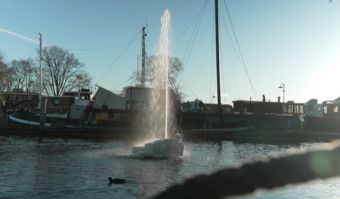
Picture above: Circulate. For the project Circulate. Designing Digital Platforms for Resource Communities, Design researcher Tara Karpinski made the Ener-geyser – a data fountain visualizing the energy use on a local grid in real time, as a conversation piece to discuss the values at stake in the algorithms that optimize energy exchange. Copyright by Tara Karpinsk and Public Art Lab
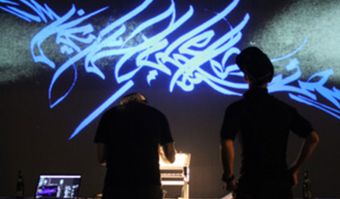
Picture above: Digital Calligraffiti 2017-21 commissioned by Public Art Lab in cooperation with the artists Michael Ang, Don Karl and Hamza Abu Ayyash, Copyright by Michael Ang and Public Art Lab
CONNECTING CITIES: Urban Screens mediate togetherness of distant publics
The European Lighthouse project CONNECTING CITIES8 explores translocal exchange through artistic practices, the networked infrastructure of urban screens, media facades and projection walls worldwide. Its goal is to engage citizens from distant places in new creative forms of togetherness and exchange. Under the guiding principle ‚Urban Screens are our Walls’, the CONNECTING CITIES NETWORK transforms these digital infrastructures into platforms and visualisation zones which provide new opportunities for communication, community building and translocal dialogue and telepresent scenarios in the public space by overlapping layers of virtual reality, augmented reality and networked society. For example, DIGITAL CALLIGRAFFITI9 allows all social groups to freely share their messages, wishes and visions on burning issues of our society. It combines the traditional cultural technique of calligraphy and graffiti with the possibilities of urban media art and new technologies. DIGITAL CALLIGRAFFITI transforms walls and digital screens into a canvas of civic expression to build bridges of intercultural understanding and promoting diversities as the medium to bring us closer.
A Vision for a Responsible Citizen-based Renaissance
The use of urban media technologies such as sensing and interaction technologies, social media, virtual and augmented reality tools and streaming solutions can strengthen community building and civic engagement in novel placemaking practices—such “responsive placemaking” promotes the democratisation of public space, facilitates public awareness about the urgencies of climate change with potential worldly resonance and enables the togetherness of people in dispersed and diverse locations. This multidimensional responsiveness of placemaking inserts citizen bottom up process in urban development of newly emerging resilient cities—such as the 100 Carbon-Neutral Cities in Europe til 2030—and will be part and parcel of Responsible Next Renaissance, responsive and responsible to its citizen-driven novel arts and technologies.
References
1 Appadurai, A. (1996). Modernity al large: cultural dimensions of globalization, volume 1. U of Minnesota Press.
2 William H. Whyte in City: Rediscovering the Center (1988)
3 Acuto, M. 2020, ‘Will COVID-19 Make Us Think of Cities Differently?’: https://newcities.org/the-big-picture-will-covid-19-make-us-think-cities-differently/
4 Federico Parolotto, F. 2020, ‘Mobility in the Age of Coronavirus’: https://newcities.org/the-big-picture-mobility-in-the-age-of-coronavirus/
5 Public Face is commissioned by Public Art for the Media Facades Festival 2010 http://connectingcities.net/project/mood-gasometer
6 Media Facades Festival 2010 is initiated by Mirjam Struppek and Susa Pop, Public Art Lab http://mediafacades.eu
8 The Connecting Cities Network is co-funded by the European Union / Culture Programme 2007-2013 and initiated by Public Art Lab http://connectingcities.net/
9 Digital Calligraffiti initiated by Public Art Lab in cooperation with Don Karl, Michael Ang and Hamza Abu Ayash
Susa Pop
Susa Pop is co-founding director of the platforms Public Art Lab and the Connecting Cities Network which contribute to creative citymaking, citizen science and translocal dialogue that empower social interactions and citizens‘ engagement. Susa Pop is an expert in investigating, curating, and producing artistic projects in the urban public sphere at the intersection of media arts, urban planning and digital naturalism. Best showcases include Mobile Studios, Media Facades Festivals, Urban Screens Innovation Forum, Connecting Cities, Future DiverCities, Digital Calligraffiti, Renewable Energy Avantgarde, Augmented Europe, Connecting Cinemas in Rural Areas. She holds lectures worldwide and gives seminars at the Bauhaus University Weimar / Media Architecture. She is co-editor of Urban Media Art Cultures (avedition, 2012) and What Urban Media Art Can Do – Why, When, Where, and How? (av edition, 2016). In 2017 she co-initiated the globally networked Urban Media Art Academy together with Tana Toft Ag in cooperation with the Goethe-Institut Thailand.
Picture © Ruthe Zuntz
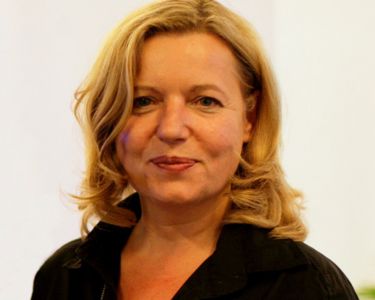
Martijn de Waal
Martijn de Waal is a professor at the research group Civic Interaction Design at the Amsterdam University of Applied Sciences. His work focuses on the experience of public spaces in a networked society and investigates the design of digital technologies from a perspective of public values. Recent research projects include The Hackable City on practices of collaborative citymaking; Circulate on the design of digital platforms for commons-based research communities and From Prevention to Resilience on the role of public space design in making neighborhoods more resilient in the aftermath of the Covid-crisis. He was the general chair for the Media Architecture Biennale 20. Key publications include The Platform Society. Public Values in a Connective World (Oxford University Press, with José van Dijck and Thomas Poell), The City as Interface. How New Media Are Changing the City (Nai010 Uitgevers) and The Hackable City. Digital Media and Collaborative City-Making in the Network Society (edited together with Michiel de Lange).
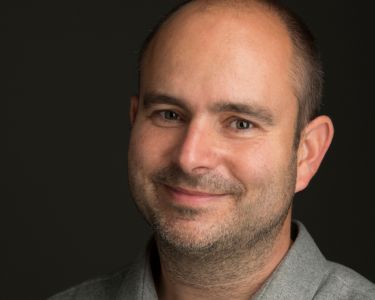
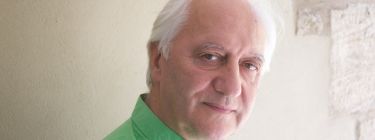
Riding the rapids of the great transformation
Charles Landry, inventor of Creative City concept and Co-Founder Creative Bureaucracy Festival, Berlin
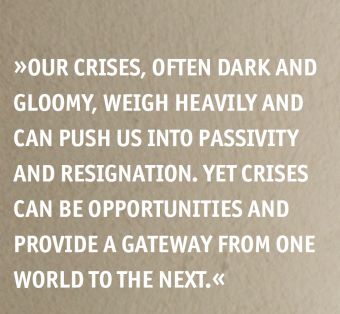
Riding the rapids of the great transformation
The place to be
Periods of history involving mass transformation, like the Enlightenment, the Industrial Revolution or the technological revolution of the past fifty years are cultural shifts. They involve major adjustments in attitudes, ways of being and mindset. They can produce confusion yet also a sense of liberation and a mindshift combined with a feeling of being swept along by events. There were delights and dilemmas as they unfolded. Now, by contrast, the temper of the age, the Zeitgeist, is one of uncertainty, foreboding, vulnerability and lack of control over overweening global forces—especially our urgency to avert climate collapse or to avoid the polarising narratives that poison civilised conversation.
It is hard to see a way to a golden age, especially since we know we need to shift our economic order and a way of life that is materially expansive, socially divisive and environmentally hostile. And doing that cannot be grasped by a business-as-usual approach as it takes a while for new ethical stances and new ways of operating to take root and to establish a new and coherent world view.
Is there light at the end of the horizon in facing those challenges, even though some feel Europe is at the edge of exhaustion and without the energy or motivation to think, plan and act afresh and with vigour? Is that really so?
Will-o'-the-wisps?
Our crises, often dark and gloomy, weigh heavily and can push us into passivity and resignation. Yet crises can be opportunities and provide a gateway from one world to the next. Take a helicopter view of the vast range of initiatives happening, large and small, across Europe and beyond to address the solutions to create a more human- and nature-centred world and you see some positive patterns. Still, for the moment, fragmented and without sufficient power and traction, big agendas are coming together in unprecedented ways and driving this change are many: activists, civil society, politicians, researchers, inventors, artists, entrepreneurs, business, writers and more. There is a mood and a movement emerging. We are seeing the possibility of creating a different world driven on other principles. There is a Planet B in sight, even though to get there we must get Planet A right.
It is a compelling story. Think how eco-principles are beginning to shape our mindset and how that provides the frame and therefore
courage to move towards a green transition where the circular economy notion plays a crucial part. Think too how newer concepts like resilience help us work through the tasks ahead or how co-creation and the participatory imperative helps harness the collective imagination (since transformation is a collective endeavour). Think here too of the notion that the world is our commons. And not to forget a digitising world that allows, in particular, the cultural creative economy to run through systems like electricity in its inventiveness and with its immersive capacities. Sometimes the speed of the possibilities are dizzying and we always must be alert that we, rather than the technologies, are in control.
There is convergence and it is happening at escalating speed. From the beginning of the 21st century we finally saw a rapprochement between the two great ways of exploration, discovery and knowing: Art and Science. That rapprochement began to break down the widespread mutual incomprehension between the arts and sciences. The premise is that the most fruitful
developments in human thinking frequently take place at those points where different lines of creativity meet. By sharing their creativities, ways of knowing and the knowledge it enables, scientists and artists enrich and maximise each other’s potential and so encourage innovation. The transdisciplinary perspective is powerful when boundaries erode and as the methods of exploration and problem-solving can combine the linear, analytical and logical as well as the visual, kinaesthetic, spatial and musical. Allied to technologies that help shift ideas into reality, these synergies promote new forms of creativity which can result in ideas that can be turned successfully into products, services and solutions. This is the radical technological and cultural revolution underway. It has great opportunities. Together it is all transformative.
Incessantly, however, a bigger question remains ever-present and it needs to be answered: How do you make people feel viscerally that they must transform and change their minds—even while people realise that the world stands at the cusp of a crucial moment? Time is short in which to make the big difference towards one-planet living and we need to harness and share our collective talents, will, energy, intelligence and resources.
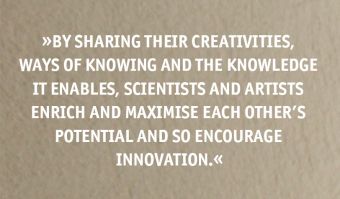
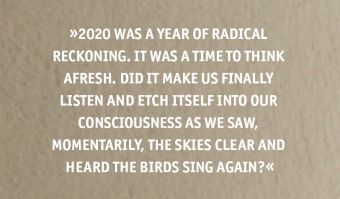
The year 2020 glitch
2020 was a year of radical reckoning. It was a time to think afresh. Did it make us finally listen and etch itself into our consciousness as we saw, momentarily, the skies clear and heard the birds sing again? This forced experiment of reducing carbon emissions gave us a glimpse of a possible other world. It reminded us that the world of ‘more and more’ cannot go on even though many still think of the old normal as our desirable and exotic destination. Crises like the pandemic provoke a dramatic reordering of priorities, deep reflection and rethinking and focused us—or at least should have—on what really matters: the common good and public interest. We saw too that, as Tom Burke put it, “civilisation is the thin film of order around the chaos of events.”
The pandemic was a wake-up call which triggered a dawning of humility as our collective hubris was humbled and old certainties crumbled. The pandemic created both clarity and confusion as in the eye of the storm it is difficult to see “where next” and how to get there. There seems to be no blueprint for how to move forward, yet we do have them.
We have an image of what could be: a zero-carbon society, a gender-equal society, a world where the dividends rather than the threats of diversity are promoted. The solutions are there but we think too often that technology will sort it out and that we can continue to just act as before. Technology takes on the responsibility and authority. We abnegate, we feel less answerable to what is happening. Shifting our mindset and how we think, plan and act—our behaviour—is the far bigger task.
Taking an eagle-eye view of the world in motion demands we unscramble the nested complexities and look at existing trends in order to assess their depth or superficiality, their characteristics and the nature of their impacts.
A good analogy is to think of change like an ocean. Ripples on the surface are less important than waves of increasing significance, which are themselves formed by tides, currents, climatic changes and
geological events which shape the movement and dynamics of the whole—and which might produce the occasional tsunami. It is that tsunami we need to avert.
We know the direction of travel if we do not act and it is the deep trends—think climate change—that we need to address. The challenge for all of us is to distinguish between the important, the less significant and the trivial: to understand the difference between a trend and a fad. And some trends are as persistent as they are predictable—just consider that when I was born the world population was about 2 ½ billion and when I die it will be more than 8 billion people. Not surprisingly, nature is suffering. Think water shortages, deforestation and animal extinctions. All are inextricably interwoven. In addition to this we are still operating largely with the same institutional structures made for a different age.
Variation of the mind
To make the rebirth—perhaps a Renaissance—a reality requires us to shift our mindset dramatically. That mindset should see things as an integrated whole. But this is not to downgrade the specialist—it is simply that we need to grasp the interconnections. Is it crisis, danger, the fear of impending doom, awareness, knowledge or is it a thoughtful, inclusive mind that shifts our thinking? This means understanding mindsets, mindflows and mindshifts. It implies reassessing how we think and learn, what we learn, the intelligences harnessed, the types of information used and disregarded. It demands new criteria to discriminate, judge and filter and a broader perspective which embodies a more inclusive sense of possible resources that are more free-flowing, lateral and creative. A changed mindset, rethought principles, new ways of understanding and generating ideas are the cornerstones of change.
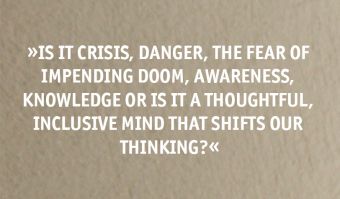
A mindset is the order within which people structure their worlds and how they make choices, both practical and idealistic, based on values, philosophy, traditions, experience and aspirations. Mindset is our accustomed, convenient way of thinking and guide to decision-making. It not only determines how we act in our small local world, but also how we think and act on an ever-encompassing stage. Mindset is the settled summary of our prejudices and priorities and the rationalisations we give them. A changed mindset is a re-rationalisation of a person’s behaviour and is difficult as people like their behaviour to be coherent—at least to themselves.
Mindflow is the mind in operation. The mind is locked into certain patterns for good reason. To cope with the world we focus on the familiar, whether thought processes, attitudes, concepts and interpretations. The environment or context determines what is seen and what meaning is given. It operates below the level of conscious awareness. We cannot be completely open 24/7 although our default position must be a willingness to re-assess. Most of us will look at the world or a problem in a learnt way and have vested interests in perpetuating our current practices. An open focus can be seen as threatening, especially for discipline specialists as this might challenge the authority of their profession.
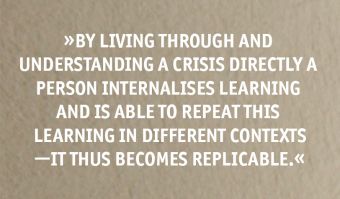
A mindshift is the process of dramatically reassessing core ideas. But how can you relax when there are pressures around you? Changing a mindset is unsettling and potentially frightening. Transformative effects happen in differing degrees: direct experience, seeing things work and fail and through conceptual knowledge. The most powerful means is the direct experience of having to change behaviour. This is where crisis comes in. By living through and understanding a crisis directly a person internalises learning and is able to repeat this learning in different contexts—it thus becomes replicable.
The challenge here Is that we travel with a weight of history attuned to bipolar thinking, operating in silos and are often sceptical of integrated, 360-degree perspectives and transdisciplinary thinking. Yet that cannot generate the solutions the future requires. The greater the number of perspectives applied to a problem, the more
imaginatively will it be approached. This is not to deny the value of our existing specialist knowledge. We cannot all simultaneously have the skills of an engineer, a biochemist or environmentalist, but we can understand their essence and so merge them with other skills or insights to make them more effective. This integration with other skills—especially in the human and social sciences, such as history, anthropology, sociology and psychology—has too often been lost in most affairs. For instance, a traffic issue is never only about cars and land use. If transport planners had understood psychology or culture better or the ideas of mental geography, they would have been more careful about building urban motorways that scorch their route through communities.
So, how can youthink small and with less when we are used to thinking big and with more? This transformation is a cultural project, the biggest of our times, as it is about values, mindset, attitudes and hearts, minds and skills. Seeing things culturally is powerful as culture is who we are. Creativity helps shape what we can become.
There are various ways to change behaviour and mindset: to coerce through force or regulation; to induce through payment or incentives; to convince through argument; to con, fool or trick people; to seduce (an odd combination of the voluntary and involuntary); and finally to create and publicise aspirational models. It is the latter we need to
focus on and it is not as straightforward as it sounds. It is likely to be a combination of all persuasive devices that takes into account immediate, short- and long-term impacts. At times the slowest way of changing a mindset can be by rational argument; yet while longer, it is the most effective, especially when evidence based.
This is where storytelling comes in and understanding the distinction between forms of communication—especially the narrative and iconic. Narrative communication is concerned with creating arguments; it takes time and promotes reflection and is linked to critical thinking; we build understanding piece by piece. Iconic communication by contrast seeks to ‘squash meaning’ and to crisply encapsulate an essence in order to create high impact and to show that what is being said feels significant. Our challenge is to embed narrative qualities and deeper, principled understandings within projects which have iconic power. This is where the talents embedded within the creative economy are so significant. They can create the messaging, the products, the experiences that are emblematic and which can leapfrog learning and avoid lengthy explanatory narratives through the force of their ideas, their projects and the symbolism they engender. The iconic project says it in one go and as you reflect, you understand what it is about.
How artists and those in the creative economy can help
What exactly is it about the process and act of singing, writing, dancing, acting, performing music, sculpting, painting, designing or drawing that is so special? Participating in these activities arguably harnesses the imaginary realm to a degree that other disciplines such as sports or much of science, which are more rule-bound and precise, do not. The latter tend to be ends in themselves, they do not change the way you perceive society; they tend to teach you something specific. This process of imagining has the benefit of forcing us to reflect, to develop original thought, to confront challenges and, crucially, to imagine that Planet B, which is where we need to get to. Nursing us through a green transition is a creative act where involvement with the arts can help.
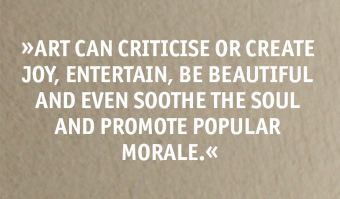
Engagement with the creative activities combines both stretching oneself and focusing; feeling the senses and expressing emotion. Art, for instance, can broaden horizons and convey meaning with immediacy as well as depth; it can facilitate immediate and profound communication; symbolise complex ideas and emotions or encapsulate previously scattered thoughts; anchor identity and enhance communal bonds or, conversely, stun and shock for social, moral, or thought-provoking ends. Art can criticise or create joy, entertain, be beautiful and even soothe the soul and promote popular morale. More broadly, expression through the arts is a way of passing ideas and concepts on to later generations in a (somewhat) universal language.
What art does is not a linear process. Humans are largely driven by their sensory and emotional landscape in spite of centuries of developing scientific knowledge and logical, analytical, abstract and technical thought. We are not rational in a scientific sense, but we are a-rational rather than irrational. This is why all cultures develop arts.
What are the elements that help transformation along the way? We see here a combination of urgency, perhaps a crisis, and increasing evidence that the old ways do not work. Then a new concept comes in that encapsulates a way forward, as when the notion of sustainability emerged especially after the Club of Rome report in 1972. That in turn can drive an intent, a vision, a mission. Missions act as calls to action and as gathering devices to bring interests together towards a common aim. Crucially, we need real-life projects that embed the intent as it is only the lived experience of, say, a sustainability
initiative in action that makes an abstract concept real. Think here of the 15-minute city idea popularised by Paris and its focus on the city of proximity where walking, ease of access and most facilities are nearby and local. Here what might have seemed invisible becomes visible.
This reminds us that the new thinking needs to impact at three levels—the conceptual, the discipline-based and the implementational. It involves, additionally, reviewing the detailed mechanisms to make things happen, such as financial arrangements or planning codes to encourage and direct development into certain directions.
New thinking can generate a rebirth—a Renaissance. This Renaissance could unleash a process of re-enchantment that speaks to our deepest yearnings, our soul and our sense of wanting to become whole again where we and the world around us have the right balance.
Great placemaking is an art not a formula, but strong principles can help us along the way. For a long time I pondered, What are great places beyond their need to provide the means of survival and shelter and to be environmentally responsible? Five core themes came to mind: “places of anchorage and distinctiveness”, “places of connection and communication”, “places of opportunity and ambition”, “places of nurture and nourishment” and “places of inspiration and imagination”.
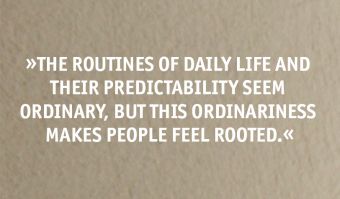
A place of anchorage and distinctiveness
This place feels like home. It generates a sense of the known, it is familiar and comforting, it feels safe and this is a place where I am sheltered and that creates a sense of belonging. It is distinctively itself. It celebrates where it comes from. It acknowledges its past, its heritage, its traditions and core assumptions about who it is. Its multiple identities, its ideas, its visions are etched into its way of life and this is what makes it special and unique. This place explains to itself where it comes from by its history, built fabric and urban design, its rituals, behaviours and activities. The routines of daily life and their predictability seem ordinary, but this ordinariness makes people feel rooted. Ironically, feeling at ease about itself gives this place confidence about where it is going and more relaxed about any changes that may unfold—so it dares to be innovative.
A place of connection and communication
This is a place of relationships, from the incidental to the casual to the deeply profound. You connect and communicate face to face with neighbours, work colleagues, friends, acquaintances and those different from you. You link to the wider world physically and digitally as well as with your past and potential futures.This place is locally bonded. It is at ease with itself and with the wider world. It reaches out. It is relaxed about meshing its diversities. There is seamless connectivity enabled by high quality urban design, good gathering places and possibilities for chance encounter. Its walkability and varied transport modes—internally- and externally-focused—connect beyond the city confines. Its digital infrastructures reach out to virtual worlds stretching out far and wide. It is the hub from which your transactions with the world flow—both those near to you and those afar.
A place of opportunity and ambition
This place fosters open-mindedness. It encourages a culture of curiosity, it provides choices, options and possibilities in our differing phases of life. It has a ‘can do’ attitude. There is an experimental culture and this keeps it flexible and adaptive to emerging circumstances and changes.Some places provide opportunities and others less so, yet this is a place in which to have ambition, ideals and aspiration. It sparks in you the desire to give free rein to your exploratory instinct and to open out. The raw materials of the city create the potential and are embodied in peoples’ creativity, skills and talents as well as its material resources. These are “things” like buildings and also symbols, activities and the repertoire of local products in crafts, manufacturing and services. They are our historical, industrial and artistic assets including architecture, urban landscapes and landmarks as well as our indigenous traditions of public life, festivals, rituals and stories, hobbies, enthusiasms and amateur cultural activities. This draws attention to the distinctive, unique and the special in any place. These resources are all potential opportunities. Acknowledging this can engender a spirit of generosity. It can create the desire to give back to your city. This helps generate civic pride, loyalty and trust.
A place of nurture and nourishment
In this place people can flourish and there are many opportunities to self-improve from the formal to the informal. This is a lifelong learning environment and a place where a culture of discussion is vibrant. This place cares about every aspect of your life. Here you can grow personally and professionally and the city helps you in this endeavour. It reinforces your necessary ladders of opportunity to move forward. It provides accessibility and enables mobility and helps move away constraints. It enables you to be more fulfilled and to widen your horizons. You are fed by these broadening perspectives and so learn and reflect. This can help citizens become more competent and confident and thus willing to participate in helping to shape, make and co-create their evolving city. To make this happen requires preconditions and these include good facilities, be they in education and research, health care, social provision, affordable housing, parks, good retailing and cultural facilities from the large-scale to the intimate. It will provide anything that makes it more liveable. Overriding everything there is a spirit of generosity and of giving back and this in turn inspires citizens to aspire to give of their better self and to become the best they can be.
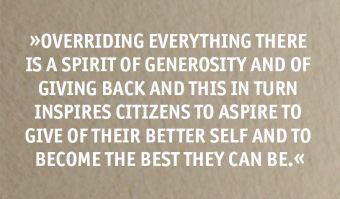
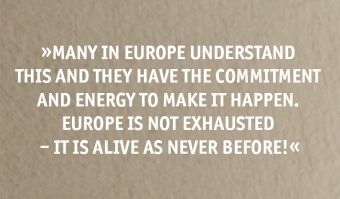
A place of inspiration and imagination
This place has a visionary feel. It lifts you up from the day-to-day. You feel at one with yourself and your city. It provides a heightened level of experience by its beauty, and what that is remains ever debatable—and so it is also a place of possibility and excitement. It allows you to envision what could be. Here, aspiration and good intent is made visible in both the built fabric and through the vitality of its culture and urban programming. Each reinforces the other and this creates a virtuous spiral. This visionary dimension reflects the ideals and ethics that the city wishes to project to its citizens and to the wider world. These greater purposes beyond self-interest change over time.
In bringing about a New Renaissance, three foci are important. First, we need to heal the division between the city and nature in a changing climate; second, we need to be imaginative in working through how we live together with our differences; and third, we need to unleash the creative potential in each one of us.
Many in Europe understand this and they have the commitment and energy to make it happen. Europe is not exhausted – it is alive as never before!
Charles Landry
Charles Landry works with cities around the world to help them make the most of their potential. He is widely acclaimed as a speaker, author, innovator and he facilitates complex urban change projects.His aim is to connect the triad culture, creativity and city making. An international authority on using imagination in creating self-sustaining urban change Charles has advised cities or given talks in over 60 countries. He helps shift how we harness possibilities and resources in reinventing our cities and his Creative City concept has become a global movement. His book The Art of City Making was voted the 2nd best book on cities ever written by the planning website: http://www.planetizen.com/node/66462. His most recent books are The Civic City in a Nomadic World and The Creative Bureaucracy with Margie Caust. The latter has become a movement with an annual festival taking place in autumn every year in Berlin. The 2021 Festival had over 18000 visitors. Other books cover the measurement of urban creativity, the digitized city, urban fragility and risk, the sensory experience cities and interculturalism. For further information: www.charleslandry.com
Picture © Lukas & Joe
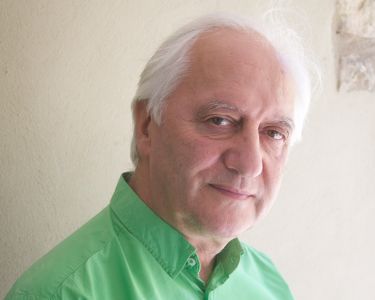
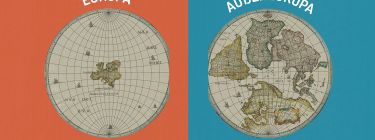
The next renaissance will be globalised
Johannes Ebert, Secretary General/ Chairman of the Board of Goethe-Institut; Nico Degenkolb, advisor for Cultural and Creative Industries projects at Goethe-Institut Head Office, Munich
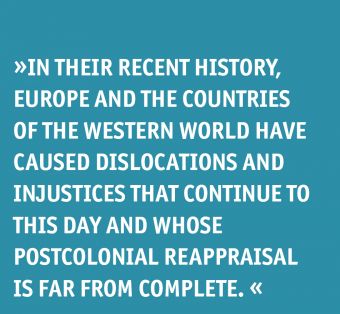
The Next Renaissance Will Be Globalised
Shaping the past, changing the future?
Renaissance, Reformation, Enlightenment, Modernity: these terms for epochs of progress and awakening continue to shape the collective identity of Europe and of the Western world to this day. Their achievements are rightly pointed out and their pioneers and representatives remembered.
However, what has increasingly entered public discourse and thus collective consciousness in recent years is a fundamental ambivalence that characterises Europe’s history of progress in the modern era—on the one hand, a claim to values shaped by humanism, and on the other, a lived practice that all too often contradicts the ideals formulated.
This contradictoriness comes to light especially in Europe’s relationship to non-Europe. On the one hand, the great Enlightenment philosopher Immanuel Kant laid the foundation for the modern, enlightened, Western worldview with the Categorical Imperative and his universalist moral and legal philosophy. On the other hand, he countered precisely this worldview with profoundly racist statements on the supposed superiority and inferiority of Europeans and non-Europeans respectively.1 In 1788, he certified the Native Americans as being „incapable of all culture“ and thus „even lower“ than the inhabitants of Africa. These and other reference points in his work are difficult to reconcile with the idea of universal human dignity postulated by Kant.
Picture above: Ebert_Degenkolb_Videostill from the project Intervention M 21 (www.decolonizem21.info) The (De)Coloni al Glossary, Part 1, Europe – Non-Europe, Copyright: Aliza Yanes & Santiago Calderón
Kant is not alone in such contradictions in thought and action, which have become the subject of critical reflection in recent years. In the most famous passage of the Declaration of Independence of the United States of America, adopted in 1776 as a progressive counter-proposal to Europe’s absolutist ancien régime, on the one hand it is considered self-evident „that all men are created equal; that they are endowed by their Creator with inalienable rights; that among these are life, liberty and the pursuit of happiness”2 — noble ideals. On the other hand, many of the authors and signatories (they were exclusively men), as slave owners, actively deprived people in their immediate surroundings of precisely these rights, not to mention centuries of discrimination against women. The unpleasant downsides were and are not infrequently ignored when progress is mentioned. On the contrary, when it is repeatedly postulated that the Muslim world finally needs an era of enlightenment or that country X or Y must finally democratise for the benefit of its population, the undertone of cultural superiority that can already be found with Martin Luther, Immanuel Kant or Thomas Jefferson often resonates.

In their recent history, Europe and the countries of the Western world have caused dislocations and injustices that continue to this day and whose postcolonial reappraisal is far from complete.
Against this background, do we even want to speak of a New European renaissance? Is there not something deeply nostalgic about the Renaissance concept, as the historian Thomas Tobias Becker recently stated in a lecture?3 „The past was [in the pre-Modern era] the Golden Age, change itself was suspect. If change was wanted, it dressed itself in the garb of return, renaissance, reformation or revolution.” Such a nostalgic understanding of a European renaissance, however, would be backward-looking, Eurocentric and ultimately hostile to progress.
A desirable progressive European renaissance that wants to be more than a nostalgic transfiguration, that rather wants to unfold a great transformational power, must be driven by openness and exchange with the world, by a clear commitment to dialogue and to the
recognition of diversity of cultural practices, by listening to each other and by cultural exchange between the Global North and the Global South. Important pillars of a global renaissance are the ideas of innovation in the cultural and creative sectors as well as the renewal of society as a whole, both within and outside Europe. European external relations and especially external cultural relations play an important role in this.
This is where the Goethe-Institut, the German cultural intermediary organisation with 157 institutes in 90 countries, comes in as an important player in European foreign cultural and educational policy with programmes that promote cultural exchange between Europe and outside Europe. It thus also provides impulses for cultural and creative economy scenes in the sense of the idea of innovation. Some examples of the Goethe-Institut’s programme work are outlined below.
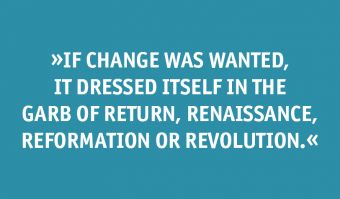
Talk about power structures
The project “Latitude“ invited a global exchange on colonial power relations from September 2019 to November 2021. In interviews, essays, festivals and numerous other formats, topics such as decolonisation, the preservation of indigenous cultures, the role of museums, restitution and the treatment of cultural heritage are negotiated. Latitude refers to the cartographic concept of a demarcation line in relation to the equator, which goes hand in hand with a distinction between the southern and northern latitudes. Through this separation, the term associatively points to inequality in terms of power relations: the imposition of the systematic power of many countries from the global North over regions from the South. Latitude is a space for respectful exchange—cultural, political, economic and aesthetic.
New focal points are regularly added to the Latitude website. Writers like Cidinha da Silva from Brazil and Philipp Khabo Koepsell from Germany, for example, have written essays on „black literature“ and its positioning in the global literature business. The constantly growing number of voices on Latitude can be accessed via a register of experts that makes the participants visible and enables networking among them. In addition, ideas and insights from many Goethe-Institut projects on decolonisation and postcolonial power relations flow into Latitude. The topics range from the return of illegally acquired art objects to the societies of origin and the decolonisation of museums to the redefinition of power relations between the West and the global South and the reorientation of postcolonial development cooperation. For example, the handling of controversial art objects from former colonies is examined from different perspectives, from experts calling for unconditional repatriation as well as from advocates of a broader spectrum of alternative approaches to cooperation between former colonies and colonial powers. These debates are necessary to gain a sense of a decolonised and anti-racist world.
Dealing with the past
Europe can learn a great deal from its past, especially with regard to its relationship with non-Europe. The Goethe-Institut’s „Shaping the Past“ project brings together initiatives from North America and Germany to develop innovative forms for anti-racist and anti-colonialist remembrance in public space. Shared remembrance and the forms it takes are always the subject of controversial discussions, which show that dealing with the past must always be renegotiated. This is all the more true in an increasingly diverse society. In North America, there is great interest in learning about alternative forms of commemorative culture, especially in light of the current debates about removing statues from public spaces. In 2022, a series of exhibitions will be developed with women artists, historians and representatives of the cultural and creative industries to explore innovative forms of remembrance as examples. This exhibition will be produced locally „on demand“ and can be shown simultaneously in various locations, museums and community-oriented venues in the USA and Europe.
Changing societies with games
Enter Africa is a creative African network represented in 15 African countries and initiated by 15 Goethe-Instituts in sub-Saharan Africa. Interdisciplinary teams of architects, urban planners, IT experts and artists in 15 African cities have come together to develop 15 location-based games for smartphones and an analogue mega-game, addressing the challenges of urban transformation, borderlessness and Africa’s past, present and future. This process has resulted in a network of creative, innovative young professionals across the African continent and European-African game developers. Together they use games and game thinking to develop visions for good societies of tomorrow. At the same time, the creative-economic component has also been taken into account.
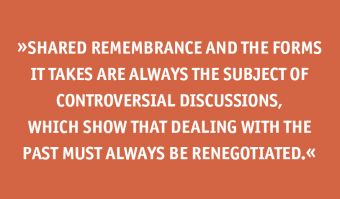
Global knowledge networks
The Covid-19 pandemic physically isolated people from each other worldwide. At the same time, the world also moved a little closer together in the digital realm through the final breakthrough of unbounded communication and learning platforms. The Goethe-Institut as a provider of global learning opportunities also found itself exposed to these opposing dynamics. The possibilities of digital learning, especially in the area of cultural and creative industries, are far from exhausted.
Since 2015, the Goethe-Institut has been testing hybrid formats with the Massive Open Online Course „Managing the Arts: Cultural Organizations in Transition“ and the „Master in Cultural Management“ degree programme run jointly with Leuphana University Lüneburg, in which more than 27,000 participants from more than 190 countries around the world have so far exchanged ideas about the work and the changing conditions of the global cultural sector and the cultural and creative industries. More than 50 lecturers from five continents share their knowledge and create a global learning platform for change through culture. As the academic director of the MOOC Managing the Arts Prof. Dr. Nishant Shah puts it, „What impressed us was how many people were talking in the forum about how culture
affects social change. And how much we need arts and culture to change our society.“ If we want to meet the biggest challenges of this century—climate change, digitalisation, flight and migration—we need many more such globally oriented platforms of mutual learning. For it is these formats that enable discursive spaces for artistic, creative-economic and social innovation.
Europe and the world, or rather Europe in the world, are facing major transformations. The flashes mentioned here are only a small sample of the worldwide work of the Goethe-Institut. They make it clear that the transformations that are in full swing in many places will only succeed if we do not make the mistakes of past renaissances and revolutions again. The next renaissance must not be Eurocentric, nor chauvinistic, nor nationalistic. After the US spoken-word artist Gil Scott-Heron, The Next Renaissance will be globalised.
We can successfully meet the challenges if Europe opens up to the outside world, comes to terms with its past together with other European and non-European states, creates global spaces of exchange and encounter and enables mutual learning. The arts and the cultural and creative industries have a particularly key role to play here—they are the motor and the basis for this next future-oriented renaissance.
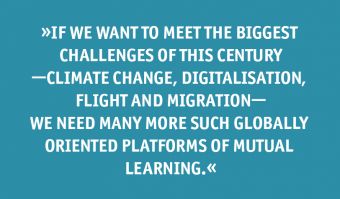
References
1 Kant, AA IX: Logik – Physische Geographie, 1802.
2 American Declaration of Independence, July 4th, 1776.
3 Nostalgie – Geschichte, Theorie, Kritik, symposium Nostalgia and Remembrance at the Leibniz Centre for Contemporary History Potsdam, July, 14th, 2021.
Johannes Ebert
Johannes Ebert is the Secretary General/ Chairman of the Board of the Goethe-Institut. Johannes Ebert graduated in Islamic Studies and Political Science in Freiburg and Damascus and finished a traineeship in journalism. After periods as an instructor at the Goethe-Institutes Prien and Riga and as deputy head of the Public Relations division in the Munich head office, he was director of the Goethe-Institut Kiev from 1997 to 2002. From 2002 to 2007 he was director of the Goethe-Institut in Cairo and regional director for North Africa and the Middle East. Subsequently he served as director of the Goethe-Institut in Moscow and regional director for Eastern Europe and Central Asia from 2007 to 2012, the year he became Secretary General/ Chairman of the Board of the Goethe-Institut.
Picture © Martin Ebert
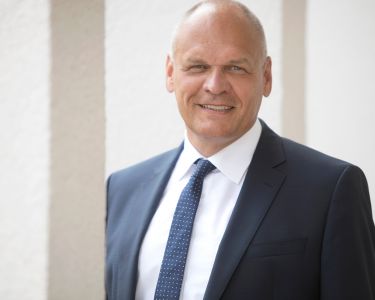
Nico Degenkolb
Nico Degenkolb joined the Goethe-Institut in 2011. He is currently advisor for Cultural and Creative Industries projects at the Goethe-Institut Head Office in Munich. From 2017 until 2020, he coordinated the bid of the City of Nürnberg for the title European Capital of Culture 2025. Nico Degenkolb holds a B.A. degree from European Cultural History from University of Augsburg and University of Seville and a M.A. degree in International Relations from Central European University.
Picture © Krischan Dietmaier
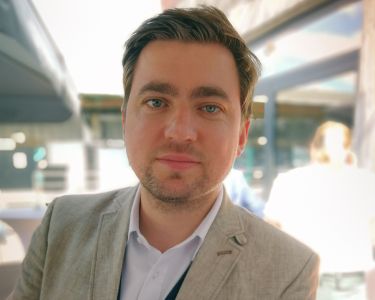
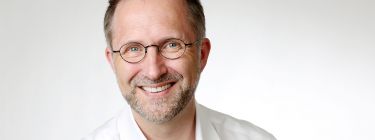
Intro: The Next Renaissance is a Renaissance of the Next
Lead of The Next Renaissance Project & Director of the European Creative Business Network (ECBN)
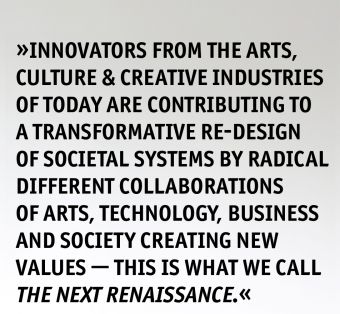
Are we the chicken or the egg?
The next and new is happening daily—in the digital world even every second—as viewers of next developments are also senders turning the next to potential news for others. One click to RT: New-ism meets Instant-ism. So is there really any room for a Renaissance, any chance to even realise the next new dimension in societies´ evolution, before it is surpassed by the next tweet, taking 100 of millions in elevators of soaring hopes or self-enhancing frustration? This is why the movement to think more slowly, more deeply and more from a 360° perspective is gaining traction.
There truly seems no shortage of the next big trend or of moon shot innovations. But there’s no shortage of crises either, from the next pandemic to the next hunger and housing crises, real estate and banking crises, mobility and climate crises. To our societies, crises are intermediate states on the way to their success, the necessary evil, for some even—as in economy—the prerequisite for recovery. This crisis concept is a pact for the wealth promise of societies after World War Two—and its social cohesion and peace.
But if crises become ever faster and ever longer, if recovery periods become shorter or are omitted, then the grand narrative of our society is less and less sustainable: “The Next Big Thing“ is longer the next thing to hope for or to expect. And even more: The belief in “Real Next“ is challenged by the relentless ticker tape of daily updates, breaking news and constant social media notifications popping up. It might be no accident that just in this setting more and more citizens believe that their children will not live a better life than their own—despite the fact that this generation has accumulated an unprecedented amount of wealth and health.
The Next?
“It is hard to see a way to a golden age, especially since we know we need to shift our economic order and a way of life that is materially expansive, socially divisive and environmentally hostile. And doing that cannot be grasped by a business-as-usual approach as it takes a while for new ethical stances and new ways of operating to take root and to establish a new and coherent world view.“1
The impression of missing out on the next is re-enforced by the ever-growing need for the next big transformations to tackle climate change and save the planet from overheating. For 30 years now, transformation toward a sustainable society has been debated in professional circles and while a bundle of theories emerged how to change complex systems in a wicked crisis—from Uwe Scheidewind’s Zukunftskunst to Mariana Mazzucato’s Mission Economy—societies at large are unwilling or reluctant to embrace change, especially quick change, without guarantees about being on the winning side after such change. Even with the emergence of activist groups like Fridays For Future—the youth-led global climate crisis strike movement—and declarations of a climate crisis in many cities, speedy realisation in societal change is not widespread. It is five minutes to midnight and still the “Next” seems to remain a grim inevitability rather than a cheerful freedom.
But what if the “Next“ is something different?
What if… generating the next generation of talents, jobs, housing, cities and streets, growth and wealth in the current system of doing the next thing no longer works given the current paradox of a raging standstill?
What if… for change of the societal pact and its structures to happen, understanding and researching the “next” as a process for the systemic “next” is necessary?
What if… the “next” is an innovative method of change-making?
The Next Renaissance!
The “next” in the 2020s must be a novel system which is able to produce the next generation of talents, jobs, housing, cities and streets, growth and wealth—and a radically different societal pact.
The World Economic Forum just published for the Davos Agenda 2022 a proposal for a radically different pact of state and business. “That redesign of all the different levers that the state has—from procurement, grants, loans, bringing in conditionality to have a proper symbiotic social contract, and more—is much harder than just talking about it… That requires a very different type of public-private partnership,” as Professor Mariana Mazzucato explains.2 in other words, a new social contract is needed. Klaus Schwab, Founder of WEG, and Thierry Malleret call for a new Great Narrative.
C40, a union of 97 cities representing 25% of the global economy, implements the “Race to Zero” global campaign for cities to “immediately proceed“ with carbon reducing projects.3
The UNESCO Creative Network pushes for a new cultural contract in society wherein the public sphere is approached “with a new perspective that public authorities, in cooperation with the private sector and civil society, can make the difference and support a more sustainable urban development suited to the practical needs of the local population.”4
In addition, industries can promote new ways of making the radical “next”—or “innovation“, as industry might call it. For example, even Digital Europe claims “creating digital inclusion and green growth.“5
Innovators from the arts, culture and creative industries of today are also contributing to a transformative re-design of societal systems by radical different collaborations of arts, technology, business and society creating new values — this is what we call the Next Renaissance.
It is all transformative
The world stands at the cusp of a critical moment. Our crises, often dark and gloomy, can be opportunities and can provide gateways from one world to the next as new agendas come together in unprecedented ways. There is a mood and a movement emerging. We are seeing the possibility of creating a different world driven by other principles. It is a compelling story. Think eco-principles and the green transition, the circular economy, new concepts like resilience, co-creation and the participatory imperative—and let’s not forget a digitising world that allows the cultural and creative economy to run through systems like electricity in its inventiveness. Together it is all-transformative.
“It is a compelling story. Think how eco-principles are beginning to shape our mindset and how that provides the frame and therefore courage to move towards a green transition where the circular economy notion plays a crucial part. Think too how newer concepts like resilience help us work through the tasks ahead or how co-creation and the participatory imperative helps harness the collective imagination (since transformation is a collective endeavour). Think here too of the notion that the world is our commons. And not to forget a digitising world that allows, in particular, the cultural creative economy to run through systems like electricity in its inventiveness and with its immersive capacities. Sometimes the speed of the possibilities are dizzying and we always must be alert that we, rather than the technologies, are in control.”6
The Green Transformation “is not just an environmental or economic project: it needs to be a new cultural project for Europe,“ as EU President Ursula von der Leyen pointed out 2021.7 And so started the lead initiative in Europe raising hopes for the Next Renaissance to really happen. But—it should be added—this will not happen without a Cultural Transformation, without a radically different pact of the arts, culture and creative industries with society.
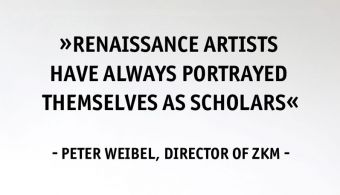
Re-Designing Systems
Our contribution to this Next Renaissance takes a closer look at examples of re-designing the systems of arts, culture and creative industries just as arts, culture and creative industries are re-designing systems of industries and markets, of cities and regions or of technologies and societal changes. And let’s not forget how the arts and culture re-design technologies.
In 1435 “Alberti published the treatise On Painting, leading to inventors using the camera obscura to automate perspectival drawing, and, within decades, Louis Daguerre and William Henry Fox Talbot industrialised it by inventing photography.“8 The iPhone took photography to a final stage of everyday use and empowered potentially everyone to be an innovator, to have a new take on and picture of the world! “Did Alberti imagine streaming media when he wrote On Painting? Imagine the value unleashed by 21st-century infrastructure of media—from streaming to 3D—which supports decades, even centuries, of progress.”9
While this book takes a closer look at examples of re-designing the systems of arts, culture and creative industries, it is not devoted to a historical analysis or even a language-sensitive analysis of historical Renaissance. While some authors here find analogies between the present-day and previous Renaissances, we did not look into the social settings of these times. Instead, this book works with an image, a perception of the historical Renaissance—but this picture does not necessarily resemble more rigorously historical representations of those earlier Renaissances that we get from scholars of the subject. For example, the word “art“ was not used in Renaissance times as we understand that term today. In fact, Science and Art were not distinguished as separate fields in the historical Renaissance as they are today.
Rethought Principles
So we must be strict and clarify a rule: Talking of a Renaissance today does not give us any vocabulary or even an understanding with which to discuss the historical Renaissance. Nevertheless, we are able to develop our own fiction of a future—even if it is built on a fiction of historical truth.
However, the creative economy also redesigns attitudes, behaviours and values: “A changed mindset, rethought principles, new ways of understanding and generating ideas are the cornerstones of change.” 10 After a first rush of technological solutions for a resilient society—the early (almost naïve) Smart City Movement—it is now common sense that without citizen engagement and their adaption of new values and behaviours a resilient society will not succeed.
“The Next Renaissance”’ is a collection of diverging perspectives which are nevertheless all united in one purpose: to thrive and unite through the diversity of creativity and culture for a new social system of changes which is as inclusive as possible—though which in addition takes the uncomfortable beyond the horizon into account. Of course, debating the Next Renaissance is an ongoing, inherently incomplete and—if you like—systematically a-rational undertaking; still it is unavoidably necessary. In the diversity of contributions we received, we discovered common threads for a system re-design—and we might discover other threads as well.
We decided to share these joint “rethought principles” and cluster the book accordingly, taking it as an opportunity to overcome the idea that a system re-design for an inclusive transformation towards a resilient society can be built on sectorial clusters—on a 19th-century thought model of excluding professions from value chains by defining artificial sectorial borders.
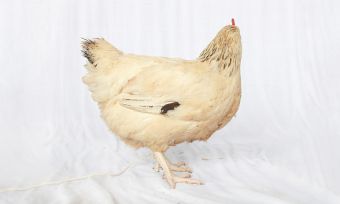
Appraisal, not Praise
This book is published in a time of “constant lip service to Renaissance that is so much characteristic of our times. The self-made digital economy tycoons like Steve Jobs, Sergey Brin and Larry Page, or Elon Musk are celebrated as the contemporary equivalents of the Renaissance man…Samuel Beckett’s ‘Fail again. Fail better’ quote has become the most famous inspirational quote of Silicon Valley culture.”11
We must aim not for praise, but for appraisal, a critical assessment of the European role in a global re-design12 and self-reflections. Still, we must not lose sight of the unique capacity of culture, as Geoff Mulgan says, “the imaginative space that is so badly needed now… That may also prompt [them] to work harder to be part of the solutions rather than part of the problem and to help us to be actors not just observers.”13
Time is short to make the big difference and driving this change are many—politicians, activists, civil society, researchers, inventors, artists, entrepreneurs, business, writers and more. We need to harness their collective talents, will, energy, intelligence and resources to create a more human-centred world based on one-planet living.
Innovators in the creative economy—at least all the contributors in this publication—share the commitment and the belief that the Next Renaissance is empowering citizens to be more creative in shaping their own future. In a nutshell: Now is the time to act and to turn ideas into reality.
No chickening out.
Sources
1 Charles Landry
2 https://www.weforum.org/agenda/2022/01/mariana-mazzucato-on-rethinking-the-state/
3 https://www.c40.org/what-we-do/building-a-movement/cities-race-to-zero/
4 https://en.unesco.org/creative-cities/content/why-creativity-why-cities
5 https://www.digitaleurope.org/about-us/
6 Charles Landry
7 von der Leyen, https://europa.eu/new-european-bauhaus/index_en
8 Ali Hossaini
9 Ali Hossaini
10 Charles Landry
11 Pier Luigi Sacco
12 Johannes Ebert
13 Geoff Mulgan
Bernd Fesel
Initiator & Lead of The Next Renaissance Project and Managing Director European Creative Business Network
Mr. Fesel has experience in CCSI for over 30 years and is currently the director of the European Creative Business Network (ECBN), a not-for-profit organization of over 170 members from 44 countries that supports and develops the cultural and creative industries in Europe. Prior to this role, he was a serial entrepreneur within the CCSI sector, held the role of vice director of the European Capital of Culture in the Ruhr Region and was senior advisor to the legacy institute of RUHR.2010 til 2018: the european centre for creative economy in Dortmund. He played a key role in EU initiatives such as like JRC-Creative City Monitor, Voices for Culture program and ENTACT and setup a European Research Alliance on Spillover-Effects of Culture and Creativity. Since 1990 Bernd is founder of startups, architect of novel public organisations, inspirator for programs and policies for CCSI, friend and connector of acclaimed artists as well as influencer and publisher. Also he was appointed adjunct professor at the Caspar-David-Friedrich-Institut in Greifswald.
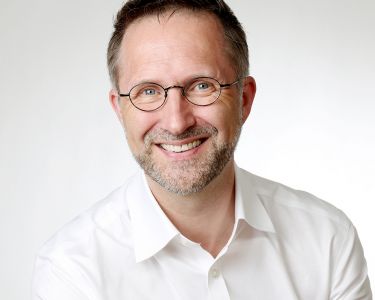

The future belongs to the creative
Hamburg Kreativ Gesellschaft

The future belongs to the creative
How companies use the potential of the creative industries to stay innovative
Tesla is not a car manufacturer. Tesla is a software company that also makes cars. The car is one product of many, limits are not set. Tesla founder Elon Musk always thinks in terms of opportunities and possibilities, but never in terms of traditions. And that’s new. These are new realities of life that now pose major challenges for numerous companies, especially when it comes to developing innovations. Because tomorrow’s innovations are at odds with today’s industries. In this piece Hamburg Kreativ Gesellschaft mbH shows how looking into the future of content and creative industries is a tool to improve innovation today—across all industries.
The automotive industry is currently experiencing new realities very accutely, especially as it is in the midst of the biggest transformation process in its history. If we leave aside the most obvious challenge—namely the technical component—from the combustion engine to the emission-free automobile, we see a development whose dimensions should not be underestimated: User behaviour is changing dramatically. Not everyone wants their own car and car-sharing is becoming more and more common. In addition, there is a growing environmental awareness, but also social areas of conflict (for example, available and affordable housing) are displacing the supposed self-evidence of owning a car.
Picture above: Welcome at Play Day Final, Copyright by Laura Müller
Picture left: Demo Prototype, Copyright by Laura Müller
The image of the future
The new mobility—especially in large cities—is creating an acute need for innovation in the industry far beyond the ecological-technological sphere. Thus, data- and content-based business models are becoming a central component of a sustainable business model. For the automotive industry (as for many other industries), it will also be a matter of crossing previous industry boundaries and working in an interdisciplinary manner in order to remain capable of innovation. Above all, however, companies will have to deal more and more intensively with the future. We often still cling to the idea that we can’t determine the future, but that it will be determined. But that may prove to be a mistake. Instead, we will have to create tools and methods to really look ahead. Only in this way will the picture emerge toward which we must work.
In 2019, nextMedia.Hamburg and the Cross Innovation Hub (part of Hamburg Kreativ Gesellschaft mbH) developed Content Foresight, a unique, Europe-wide tool for bringing together different perspectives, different know-how, different inspirations, and also very different creative approaches in a media- and technology-diffuse world. Content Foresight has since proven to be a highly effective method for making reliable predictions for the content industry based on creative input and interdisciplinary collaboration with other industries. Just one example: If autonomous driving becomes established in the medium term, mobility providers in particular will have to become much more involved in other business areas than before. Because when the car drives itself, drivers will have time and space for new forms of occupation, new forms of media use. This, in turn, requires creative and content-related input, i.e., content! And that promises enormous potential for creative and media professionals.
Content Foresight promotes creative innovation work
The Content Foresight innovation program we developed is a tool for testing new applications and future business areas for the content and media industry. Content Foresight is based on the research-proven methods of Strategic Foresight and was adapted and further developed by us for the content industry. Beyond the productive interdisciplinary setting, Content Foresight thrives on impulses, ways of thinking and specific skills of external creative professionals who are included in the innovation process. These professionals come from the different submarkets of the creative industries to form a so-called „pool of creatives“. As part of the project, they are not only paid for their contributions, but also meet the participating companies at eye level and can build a new network. Applicants so far have been people from the various submarkets of the creative industries, with a focus on different digital competencies, i.e. software development, PC games, interaction/UX design, sound, virtual and augmented reality and storytelling.
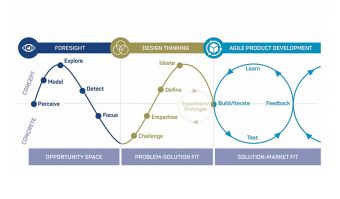
The new renaissance of the creative
The „New Renaissance“ that is emerging now, at the beginning of the 21st century, will have to leave behind the purely growth-oriented, resource-consuming innovations and thus bring about socially desirable changes. The term Renaissance was chosen deliberately because the „old“ Renaissance, i.e. the period between the 14th and 16th centuries, led to a boost in innovation in various areas; it was the time when technology and art, science and creativity merged. We want to build on this—especially in times of the COVID-19 pandemic—in order to contribute to overcoming the crises of our time. Because it is a sector that we hold in high esteem which is becoming the driving force behind this movement: the creative industries. It seems to be the sustainable winner in the merging of all areas of our lives. It is characteristic of the new renaissance that problems and crises can be solved more and more effectively across all areas and sectors. What was once separate, the creative person is able to connect with bridges and lead to innovative solutions. The creative industries are now an innovation-driving sector of the economy that is successfully leading other economic players into the new renaissance.
Picture left: Foresight Process / Copyright: Rohrbeck Heger GmbH
In recent years, the content-producing players in the creative industries—the publishing, media and music sectors, and of course journalism—have been the first sectors to digitise and transform themselves and they continue to do so. This is because the traditional media companies are facing a permanent change in terms of the behaviour and demands of the users of their products and services. Subscriptions are becoming memberships, content providers are becoming curators, and monothematic offerings are becoming lifeworlds and services that must be able to be mapped seamlessly on all platforms. As a result, data-driven business models are moving further into the foreground. Diversified business models must be found to suit the sovereignty, flexibility, and individuality of these users. With the credo of „meeting users where they are“, the industry has had a self-imposed target since the 2010s and continues to be dependent on technology and data, and thus on monopoly-like infrastructure providers, such as platforms, software and hardware providers. One also observes within the content industry an increasing merger of different providers into cooperations, alliances or mergers—and with it an increasing willingness to innovate, indeed an innovative power.
In other words, the content industry has the best prerequisites for the new renaissance.
Picture right: Status Quo, Copyright by Laura Müller

Looking to the future promotes the innovative power of today
In our view, Strategic Foresight is therefore the most suitable method for bringing together areas that are supposedly alien to one another to exchange ideas and find concrete solutions to their current and future challenges. After all, looking into the future promotes innovation today. However, companies still too often face major hurdles in perceiving and exploiting this potential. But simply dealing with a time horizon of five years is still unusual in companies. In order to better cope with the approaching, rapid changes and not only remain capable of acting, but also to be able to shape the future, even more courage and willingness to take risks will be required in the future.
This willingness also includes cooperation across industry and company boundaries. Most industries and management strategies still seem to be unfamiliar with open and cross-innovation processes. Yet the increasing complexity of our world is due not least to the convergence of markets and industries. So while classic competitive thinking can make long-term innovation even more difficult, it is often neutral and supra-organisational approaches that can create new spaces of opportunity and change mindsets. And above all, the involvement of the creative industries creates additional potential. Their ways of thinking and working not only provide new impetus for the innovation process itself, but are also becoming indispensable in view of the need to shape a new, sustainable, equitable future.
Picture below: Michail Paweletz reads 2034, Copyright: Laura Müller
For the practical application of content foresight, we rely on the following approaches:
1. With a cross-innovation approach, we create a setting that is considered to be particularly conducive to innovation and can thus bring two different sectors into innovation work in a targeted manner, in which we work in a user- and solution-oriented manner with the help of methodologically sound processes.
2. The focus is on methods of strategic foresight, which not only look at the development of possible futures, but also specifically enable the identification of so-called opportunity spaces and thus recommendations for action to successfully anticipate them.
3. In the subsequent design thinking process, concrete prototypes are developed alongside the joint visions. In addition, we rely on special impulses in these processes through targeted collaboration with actors from the creative industries.
4. As a public provider, we also act as a neutral player in this process and create trust among the companies involved and, where applicable, among competing companies.
With this setting, in a format that is unique in Europe, we are not only creating an experimental area for concrete approaches to current and future challenges, but also new impulses and foundations for the sustainable innovative capacity of the participating players.

So what do the possible futures look like when actors from the content industry work together with mobility experts? Where are the opportunity spaces? Content Foresight – Mobility by nextMedia.Hamburg and the Cross Innovation Hub produced the following triad of innovations:
Business ideas using the example of the content & mobility interface
I.
2024. For a time horizon of five years, the Hamburger Morgenpost and Schwan Communications have developed a tangible solution for linking content and mobility offers that can already be implemented with current technologies. The prototype Digital Guided Tour /HAM offers users multimedia content (video, audio, text) that functions in a wide variety of means of transportation, is coupled with them, and whose playout is adapted to the means of transportation. In this way, it not only offers content providers new distribution channels, but also creates incentives for the use of public and/or climate-friendly means of transport in the city—from e-scooters to sharing offers and public transport. This applies not only to local residents, but also to the more than seven million tourists who visit the Hanseatic city every year, thanks to the integration of tourist attractions and historical content.
II.
2029. The project team of MaibornWolff and pilot Hamburg planned the next step: With S.T.E.P—the Seamless Travel Experience Platform—mobility and entertainment/information are individually tailored to the user. Instead of having to actively choose from countless options how to get from A to B and which content can be consumed on the way, a digital twin creates situationally optimal decision bases for seamless travel planning. The blockchain-based application already developed promises all-in-one processing. In a planning horizon of about five to 10 years, app chaos on smartphones will then be as much a thing of the past as login madness. Through a public-private ownership model, in which the public sector acts as a regulator, a critical mass of services and users* can be aggregated, which can fully keep an eye on the optimisation of passenger transport, independent of the economic success of individual providers.
III.
2034. What’s next? How do we envision mobility and content when blockchain technologies and AI-supported systems have long since become part of our everyday lives and our data precedes our decisions? Representatives from NDR, Axel Springer, HOCHBAHN, IAV, ITS Hamburg 2021 and Wunder Mobility give us an impression of this in their concept of experiential mobility. In the sense of a pre-prototype, the team developed a vision of mobility in a time horizon of about 15 years, which considers social (e.g. environmental protection, education), political (e.g. data sovereignty), technological (e.g. autonomous driving, artificial intelligence as technology serving people, digital identity) and individual aspects (e.g. consumption, convenience) in equal measure and integrates them into product and service scenarios.
The vision, spoken by ARD news anchor Michail Paweletz, is publicly available here.
Open even to unfamiliar input
So… You can’t do it without looking into the future. But… Everyone looks at the future differently. To find the best solution together, it is crucial to organise an exchange—and to learn from each other. This is the only way to create innovations.
If you want to be innovative tomorrow, you have to be open today, even for unusual input—and above all for new content!
Quotes from company representatives:
Dr. Johanna Leuschen, Head of NDR Audio Lab (Norddeutscher Rundfunk)
„We believe that in the future we will always get the content that is best suited to our mood, in the current mobility situation, in the time available. The keyword here is personalisation. The user focus is and will remain essential. For journalism, AI could be useful in an assisting role: Tasks that do not necessarily require creativity (weather, election or sports results) could be taken over by algorithms. Then journalists could devote themselves entirely to creative and research-intensive topics. And we assume that companies in general, not just content providers, should look at an audio and voice strategy and tailor their offerings for a voice-driven world in the long term. Discoverability is going to be a big challenge going forward.“
Nicolas Meibohm, Head of Connected Car (Axel Springer SE)
„We often still cling to the idea that we can’t determine the future, it will be determined. But that is exactly the mistake. So now, once we really look ahead, we get a picture we can work toward. This program has set a benchmark and proven that interdisciplinary collaboration really makes sense.“
Hendrik Menz, ehemals Director Business Development (pilot Screentime GmbH)
„It takes a wide range of relevant expertise and value-added fields to absorb the necessary complexity of a holistic approach.“
Dr.Nina Klaß
Dr. Nina Klaß is an expert in content and tech innovation. She leads nextMedia.Hamburg (part of Hamburg Kreativ Gesellschaft mbH) where she developed and executed a range of highly recognized innovation programs such as the Content Foresight project. Previously, she was head of digital product marketing & sales management at SPIEGEL Group. She is active as funding committee member, jury and advisor of innovation programs worldwide.
Picture © Oliver Reetz
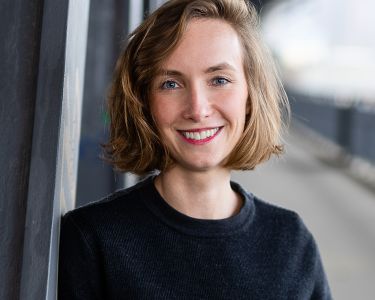
Egbert Rühl
Egbert Rühl has been active as a cultural and arts facilitator his whole life – in many different genres and functions. He is the managing director of the Hamburg Kreativ Gesellschaft. In this role, he is responsible for strategy and tactics, guidance and moderation, budget compliance, and contact with politics and administration.
Picture © Oliver Reetz

Marc Eppler
Marc Eppler is responsible for nextMedia.Hamburg’s partner management and he operates programs such as Content Foresight. Previously, he worked at the Franco-German culture channel ARTE in Strasbourg.
Picture © Oliver Reetz
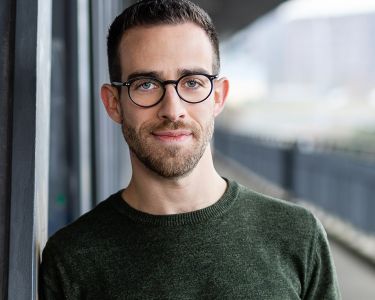
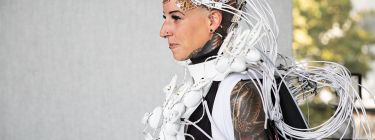
Innovation Through Universitas
Vice Rectorate for Innovation & Researchers at Johannes Kepler Universität, Linz
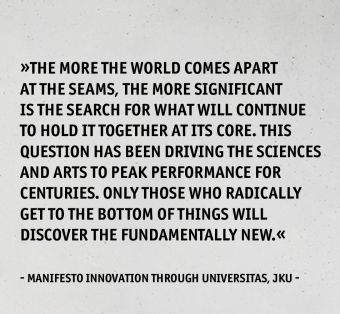
Innovation Through Universitas
The complexity and urgency of current conflict areas poses major challenges for us as a society. Digital and environmental changes are confronting us with a range of unknowns, fundamentally re-sorting our world, and doing so at an enormous speed. Automation and artificial intelligence are permeating the entire economic system, raising fundamental questions, fundamentally changing our everyday lives, and redefining human work. The consequences of global warming, from hurricanes and floods to glacier melt, are pervasive, devastating, and express the need for rapid action. The European Commission’s current work program (2021) not only puts „twin green and digital transitions“ at the top of the political agenda, but also emphasises the close intertwining of green and digital transformation. In this context, it is more important than ever to focus on their interdependencies. The Covid-19 pandemic recently showed how interdependent and interrelated everything is and how highly interconnected our world is. In a short period of time, the virus held the entire world in thrall, had an impact on all areas of our society and required cooperation across borders, institutions and disciplines.
The complexity of these challenges and the multidimensionality of networked systems require the dovetailing of different working methods, perspectives and approaches from science, business, politics, society and art. Only by entering into these synergies beyond one’s own institution, with other scientific disciplines and the integration of different actors, can novel and sustainable solutions be found. This results in a systemic change on all levels of our society. The relevance, potentials and possible practices will be elaborated in this paper using the example of higher education and the re-interweaving of art and science.
While art and science were once closely interwoven and mutually stimulating sources for the creation of something entirely new, with the end of the Renaissance they were steered in separate directions. In order to cope with the ever-increasing wealth of knowledge, the disciplines became detached from one another, leading to a high degree of specialisation and the fragmentation of knowledge.
This liaison between art and science needs to be re-established and strengthened in light of the need for innovative solutions and pressing societal and social issues. The pursuit of new knowledge and the search for solutions in the unknown have always been the driver and motor of both science and the arts.
„The analogical spirit is not only a matter of art, but also of science. May the criteria be different, artistic and scientific creativity have this in common, that it is about discovering, uncovering, endowing, or visualizing connections.“ (Gabriel 2017, p. 194)
Creative thinking, which in science as in art has led to new insights and discoveries is, as Gottfried Gabriel states, a unifying element. This makes it possible to recognise connections and to combine the familiar in new ways. As some well-known examples from the history of science show, it was often a creative idea that led to the formation of a new hypothesis, the subsequent verification of which brought the long-awaited solution to a problem. Expertise and methods for testing the hypothesis are essential. However, discovering, inventing and finding something truly new also requires creativity, which makes it possible to lead in a detached way beyond the limits of the possible.
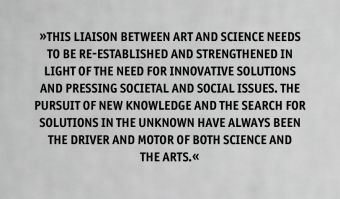
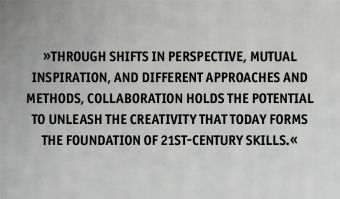
Alexander von Humboldt’s educational ideal and ideas about the university („universitas litterarum“ = „community of the sciences“) are based on holistic education in the arts and sciences and are becoming increasingly important due to current developments. Through their inherent creativity, imagination as well as execution and testing of new ideas, art and science are connected more than is generally assumed. Both are accustomed to navigating through uncharted terrain, do not shy away from complex problems, and, by exploring and creating the radically new, are the source and impetus of innovation in our society. Through shifts in perspective, mutual inspiration, and different approaches and methods, collaboration holds the potential to unleash the creativity that today forms the foundation of 21st-century skills. It is essential to focus not only on interdisciplinarity but above all on transdisciplinarity in education and research so that we do not run the risk of losing sight of the interrelationships in view of the high degree of specialisation on the one hand, and on the other hand so that new ideas can be brought into the world through mutual inspiration.
“By seeing the big picture—the interrelationships of knowledge that liberal arts offer—workers of the future can be fluid enough to adapt to changes beyond their individual control.” (Needle et al. 2007, S. 114)
This change is also clearly manifested in the change in the types of tasks occurring in the workplace. Since the 1970s, a steady increase in „non-routine analytical tasks“ and „non-routine interpersonal tasks“ can be recorded, as stated in the current OECD report. In light of the digital revolution, which is drawing a new profile of activities, „education systems must also undergo transformative change.“ (OECD 2020) The study „The Future of Employment: How susceptible are jobs to computerisation?“ by Frey and Osborn of Oxford University also caused a stir, predicting that some 47 percent of U.S. workers will be at risk. (Frey and Osborne 2013) In the study „Solving future skills Challenges“ (Universities UK 2018), the World Economic Forum and the OECD are united by the prediction that digital transformation will have a significant impact on many areas of our lives. In order to respond to these new conditions and remain capable of acting, there is a consensus that new skills will be needed, the teaching of which has been pushed too little or hardly at all to date.
“At the same time, technological change and shifts in job roles and occupational structures are transforming the demand for skills at a faster pace than ever before. Therefore, imperative for achieving such a positive vision of the future of jobs will be an economic and societal move by governments, businesses and individuals towards agile lifelong learning, as well as inclusive strategies and programmes for skills retraining and upgrading across the entire occupational spectrum. Technology-related and non-cognitive soft skills are becoming increasingly more important in tandem, and there are significant opportunities for innovative and creative multistakeholder partnerships of governments, industry employers, education providers and others to experiment and invest in new types of education and training provision that will be most useful to individuals in this new labour market context.” (World Economic Forum 2018, S. 22)
In order to prepare young people for the future world of work—the characteristics of which we can only guess at today—educational institutions have a central role and responsibility. New competencies will become necessary and require a rethinking of our knowledge transfer, learning and training opportunities and research. The rapid development of alternative models and approaches is therefore urgently needed. In addition to the acquisition of sound technical as well as broad contextual knowledge, the training of creative, social and communicative skills is central. The competence to apply this knowledge in different situations is the key to solve complex problems. Only through the power of creativity, „out of the box“ thinking, practical work and an interdisciplinary approach can entirely new ideas and approaches to solving complex problems be developed.
In the TRANSFORM project, this objective finds its first prototypical approaches. In a cooperative effort between Johannes Kepler University, the University of Applied Arts Vienna, Danube University Krems and Ars Electronica, new approaches to research and university teaching are being explored and tested. The development of future-oriented, transdisciplinary and inter-university teaching forms and formats is at the centre of the project.
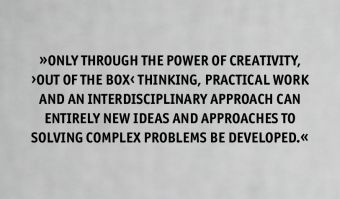
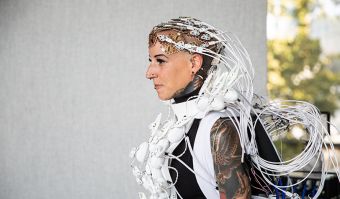
The Pangolin Scales shows how new, groundbreaking inventions can be created through the collaboration of art and science. The work was realised as part of the LIT Special Call Ars Electronica of the Johannes Kepler University Linz in 2020. The call promotes the shaping of innovative ideas through the collaboration of science and art. The Pangolin Scales features an extraordinary scale dress that moves and interacts with its environment, controlled solely by the wearer’s power of thought. This is made technically possible by a world-first, 1,024-channel brain-computer interface (BCI) that is capable of extracting information from the human brain with unprecedented resolution. It was developed by researchers at JKU’s Institute of Integrated Circuits and brain-computer interface experts at g.tec medical engineering GmbH. The impetus and inspiration for the project was provided by fashion tech designer Anouk Wipprecht, who also participated in the development. The LIT Special Call Ars Electronica Festival has been held annually since 2020.
Photo: The Pangolin Scales / Thomas Faseth (AT), Harald Pretl (AT), Christoph Guger (AT), Anouk Wipprecht (NL)
This project is part of LIT-Projects, JKU Campus. The Pangolin Scales demonstrates the world’s first 1.024 channel brain-computer interface (BCI), which is able to extract information from the human brain with an unprecedented resolution to control an interactive, fashionable dress. For further information please visit: https://ars.electronica.art/keplersgardens/en/the-pangolin-scales/
Copyright Information: Tom Mesic
Harnessing the potential of art in reshaping the European economy, in line with the goals formulated in the EU Green Deal and New European Bauhaus, is the central concern of the 12 S+T+ARTS residencies planned for 2021/22. Together with external experts from science, society, politics and business, artists will be invited to act as catalysts for change and develop concepts for a sustainable future.
As a creator of new ideas, a mediator between science and society, and a facilitator of creative, social and communicative skills, art holds enormous potential for research and education. In view of current fields of action, a closing of ranks between science and art is urgently needed, and the potential that their entanglement holds must be exploited.
References
TRANSFORM – Digital and Social Transformation through New Directions in Research and University Education is a cooperative project of Johannes Kepler University Linz, University of Applied Arts Vienna, Danube University Krems and Ars Electronica, financially enabled by the Austrian Federal Ministry of Education, Science and Research.
Zur Website
Manifest Innovation durch Universitas – written by Johannes Kepler University and the University of Applied Arts
See here: www.jku.at/en/manifest
The Pangolin Scales (2020)
Information & Videos at: Ars Electronica Festival 2020; Institutswebsite
All LIT Specialcall Ars Electronica Projects 2020: https://www.jku.at/ars-electronica-2020-in-keplers-garden/
All LIT Specialcall Ars Electronica Projects 2021: https://www.jku.at/ars-electronica-2021-a-new-digital-deal/
S+T+ARTS Regional Centres | Repairing the Present (2021/22)
The Johannes Kepler University is a scientific partner in the Challenge nº2: Circular Futures.
Sources
European Commission (2021): Commission work programme 2022. Making Europe stronger together.
Online at: https://ec.europa.eu/info/sites/default/files/cwp2022_en.pdf
Frey, Carl Benedikt; Osborne, Michael (2013): The Future of Employment: How susceptible are jobs to computerisation?
In: Oxford Martin School, 01.09.2013. Online at: https://www.oxfordmartin.ox.ac.uk/publications/the-future-of-employment/, zuletzt geprüft am 04.11.2020.
Gabriel, Gottfried (2017): Kreativität und Interdisziplinarität in den Wissenschaften.
In: Hanna Kauhaus und Norbert Krause (Hg.): Fundiert forschen. Wissenschaftliche Bildung für Promovierende und Postdocs. Wiesbaden: Springer VS, S. 191–201.
Needle, Andrew; Corbo, Christopher; Wong, Denise; Greenfeder, Gary; Raths, Linda; Fulop, Zoltan (2007): Combining Art And Science In „Arts and Sciences“ Education. In: College Teaching 55 (3), S. 114–120.
OECD (Hg.) (2020): OECD Lernkompass 2030 OECD-Projekt Future of Education and Skills 2030 – Rahmenkonzept des Lernens. Unter Mitarbeit von Bertelsmann Stiftung, Deutsche Telekom Stiftung, Education Y e.V., Global Goals Curriculum e.V., Siemens Stiftung.
Universities UK (2018): Solving future skills challenges.
Online at: https://dera.ioe.ac.uk/32069/1/solving-future-skills-challenges.pdf.
World Economic Forum (2018): The Future of Jobs Report 2018.
Online at: https://www3.weforum.org/docs/WEF_Future_of_Jobs_2018.pdf.
Kerstin Pell
Kerstin Pell works at the Vice Rector for Innovation and Researchers* at JKU and coordinates projects at the interface between art and science. She is responsible for the project „TRANSFORM – Digital and Social Transformation through New Paths in Research and University Education“ in cooperation with the University of Applied Arts Vienna and the Danube University Krems. Before that she worked in the educational and cultural sector.
Picture © JKU / Florian Voggeneder

Christopher Lindinger
Christopher Lindinger has been concerned with the social impact of new technologies and the associated cultures of innovation for more than two decades. He is considered a founding member of the Ars Electronica Futurelab and was responsible for R&D activities as co-director of the lab. Since 2019, he has been Vice Rector for Innovation and Researchers* at JKU.
Picture © JKU / Florian Voggeneder
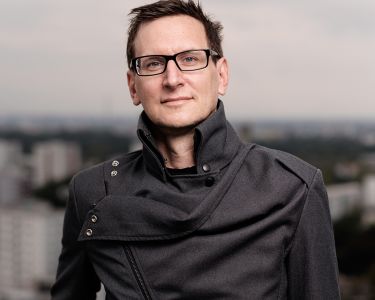
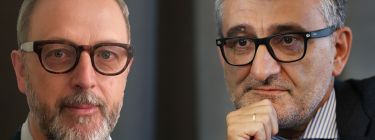
What does it mean to be human in the age of artificial intelligence?
European Commission
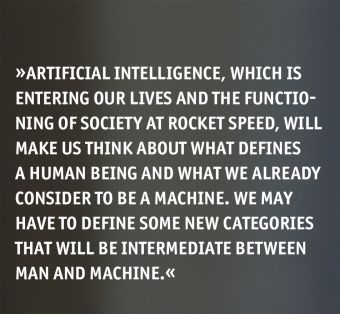
What does it mean to be human in the age of artificial intelligence?
Introduction
A friend of mine recently complained that ever since his 14-year-old son Jacob downloaded the new social networking app TikTok, he can’t seem to get away from it. My friend says he hasn’t seen this happen to his son before. What has actually been happening with Jacob and his relationship with the new app? Researcher Jason Davis, who has looked into TikTok in detail, describes it very well. Once Jacob started the app, he didn’t have to define his favourite topics or hobbies. The AI algorithms immediately went to work and started analysing Jacob’s behaviour and his emotions. They figured out what he liked and disliked. What he can stand to look at and what he quickly skips over. They started offering him all sorts of content and soon they knew Jacob better than Jacob knows himself. They knew with incredible precision which videos would engage James and which wouldn’t. What content would evoke a positive or negative emotion in him. And this is exactly what plays the most important role in the new type of economy we call the attention economy. Our time and our attention is of great economic value to digital platforms and their advertising partners, as is knowing our likes and activities.
You might say to yourself, I don’t care because I don’t use TikTok and I’m not going to. It’s just that TikTok is just a small and fairly innocuous illustration of something big and transformative that affects us all. Artificial intelligence will radically change our lives and our society. This change, which has in fact already begun, will most likely be the most profound and rapid change humanity has experienced in its existence. We need to start talking about it. Among experts, politicians, but also ordinary people. This change will affect everyone.
The question in the title of this text, which has been asked by philosophers and religious figures for hundreds, perhaps even thousands of years, does not resonate well with ordinary people. But that is likely to change in the next few years. Artificial intelligence, which is entering our lives and the functioning of society at rocket speed, will make us think about what defines a human being and what we already consider to be a machine. We may have to define some new categories that will be intermediate between man and machine. Artificial intelligence is a technology that is, in fact, for the first time in the history of mankind, entering us directly and has the potential to change not only man, but also the society in which we live. In his book Life 3.0, Max Tegmark calls for a broad discussion about the future of humanity and calls it the most important conversation of our time. But it is not just a discussion for elites. It will have to involve virtually everyone who cares about our future and wants to shape it. It is possible, even likely, that we will see more significant changes over the next ten years than we have seen in the last hundred years. This is well illustrated by this year’s report on neuro-technology by the United Nations Educational, Scientific and Cultural Organisation (UNESCO) Commission on the Ethics of Technology. In this report, the members of the Commission call for a review of fundamental human rights. Human rights were defined more than 70 years ago, primarily as the protection of citizens from dictatorial regimes. According to the authors, this is no longer sufficient and people must also be protected from technologies that have the ability to alter our thinking and enter human consciousness.
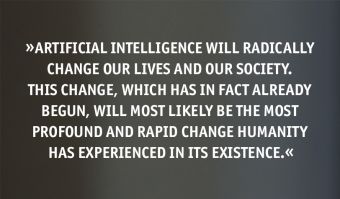
Good intentions will not protect us from transformational change
Artificial intelligence is already much better at tasks that are narrowly defined, such as recognising images, graphic patterns, sounds, and processing large data sets. Human intelligence still has the upper hand in a number of cognitive and emotional tasks, in the ability to generalise, or to diametrically change the topics it deals with in a fraction of a second. But how long will this be the case? We don’t quite know yet, but we do know that billions of euros are being invested in the world’s largest laboratories in the development of so-called general artificial intelligence that could match human intelligence on these complex issues. However, one thing is already quite clear. The interconnection and interaction between human and artificial intelligence will become a normal part of our lives. It may not even be necessary to use the future tense, as some hybrid systems already exist today. For example, to compensate for various cognitive disorders, so-called AI-based cognitive enhancers are already being used today. They are designed to treat multiple diagnoses and so Alzheimer’s patients have a good chance of seeing their condition improving soon. But what is to prevent these tools from being used on a large scale for ‚recreational‘ purposes? After all, who wouldn’t want to have a better memory, creativity or learn a foreign language faster?
Until now, humans have used their cognitive abilities based on genetic makeup, or on elaborate methods to support our thinking. This means that even the non-wealthy with good cognitive abilities were able to apply themselves in any place in society. In the future, however, this may not be the case. Technology may create a class of super-humans with abilities hardly comparable to those genetically determined. And we’re still not talking about human-brain-computer interfacing, or brain implants. These are not the fantasy and fiction of novels, but a reality being tested in laboratories and companies today. They can significantly help in the treatment of neurological diseases, but they can also lead to so-called digital immortality, in addition to a special class of super-humans. This means that after physical death, our thoughts, memory, and parts of consciousness will be able to exist in virtual space and become immortal. Are we ready for this? How will this change our society? Coping with the challenges associated with new AI-based technologies will require expanding the traditional dialectic of risks and opportunities and viewing them in a broader societal context.
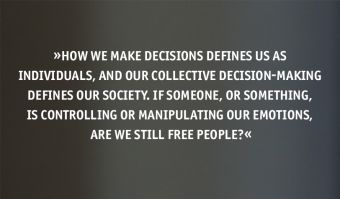
The struggle for human emotions is becoming the struggle of the 21st century
We passionately debate whether machines can have emotions and if so, what they would look like. What we completely miss is that artificial intelligence algorithms are already much better at decoding and influencing human emotions than we are. Couple this with insights from the behavioural sciences, which show that up to 85% of our decisions are based on emotion, and we can see the breadth and depth of the problem we face. How we make decisions defines us as individuals, and our collective decision-making defines our society. Whether it is making a decision in a free and direct election, deciding to buy a product, deciding on a life partner, or any other of hundreds and thousands of decisions, depends on emotions. If someone, or something, is controlling or manipulating our emotions, are we still free people? Liberal democracy and the free market are essential features of our society. But what happens to them if the free decision-making that underpins them is not free? It will not be free because the emotions that are central to decision-making will be manipulated.
Again, we can fall back on innocent intentions that can lead to problems. In the beginning, there were algorithms whose job is to keep the client engaged as long as possible with some content that is mostly „free“ and thus with the accompanying advertising that someone pays for. Artificial intelligence, which sets the algorithms, is defined as a system capable of observing its surroundings and then making autonomous decisions. Artificial intelligence has observed that negative, hateful, often deceptive content attracts people more, and so it naturally makes the decision to offer controversial content more often in order to keep people’s attention longer. One of the negative, and at the beginning probably unintended, consequences is the spread of untruths and the polarisation of society. It is certainly not the only reason for this unhappy state of affairs, but it is certainly one of the important ones. Another unfortunate impact that nobody expected, and one which we still do not fully understand, and which is most likely linked to the digital transformation, is the explosion of mental illness in children and young people. Over the last decade, this is an increase of between 15% and 25%.
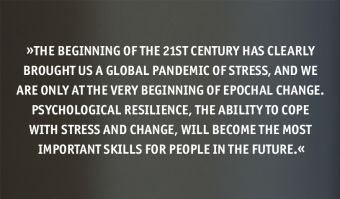
Creativity is no longer just the domain of humans
Years of digitisation of cultural content have led to unprecedented accessibility and personalisation. Today, people can watch cultural content from anywhere and at any time. At the same time, the boundary between the producer of cultural content and its consumer is gradually blurring. Artificial intelligence, which first entered the field of art and culture through personalisation of offerings and preference tracking, is now connecting, reproducing and even creating new artistic products from cultural content—music, visual art and text. At the same time, it opens up completely new horizons for artists and scientists that were unknown to them. The question of whether “machines” will become artists is becoming ever more intense. Some today radically reject it, but in all likelihood we will soon also see in art and science a fusion of the human and the „machine“, produced by artificial intelligence.
Psychological resilience will be key to life with artificial intelligence
The entry of artificial intelligence into society will bring a great deal of change to everyday life and work. Many jobs will disappear, many new ones will be created. We are already seeing a growing momentum of change in work, and this will only accelerate. This will involve the need to change established ways of working and living and to learn new skills much more frequently than has been the case to date. However, change is stressful for people. The beginning of the 21st century has clearly brought us a global pandemic of stress, and we are only at the very beginning of epochal change. Psychological resilience, the ability to cope with stress and change, will become the most important skills for people in the future. Just as we have become accustomed in recent decades to the normality of going to the gym or playing sports and strengthening our bodies, we will quickly have to get used to the need to strengthen our spirits and become psychologically resilient. This will be a shared responsibility between the education system, employers and each person individually. Emotional skills such as empathy, compassion and mindfulness, which are relatively little talked about today, will gradually come to the centre of our attention.
Conclusion
stop it. The benefits of artificial intelligence for humanity are indisputable and will be enormous. Our task is not to underestimate its transformative potential but to grow with it. We must have the courage to change ourselves and society and find new qualities in the relationship between technology and man. If we try to preserve society as it used to be, it may have unforeseeable consequences for all of us.
Vladimir Šucha
Head of European Commission Representation in the Slovak Republic
Vladimir Šucha is a Head of the European Commission Representation in the Slovak Republic since 2022. Before he was a senior policy adviser at UNESCO, detached from the European Commission. He was in the leading positions of the Joint Research Centre – a scientific and knowledge service of the European Commission since 2012. Before he spent 6 years in the position of director for culture and media in the Directorate-General for Education and Culture of the European Commission. Before joining the European Commission, he held various positions in the area of European and international affairs. Between 2005 and 2006, he was director of the Slovak Research and Development Agency, national body responsible for funding research. He worked at the Slovak Representation to the EU in Brussels as research, education and culture counselor (2000-2004). In parallel, he has followed a long-term academic and research career, being a full professor in Slovakia and visiting professor/scientist at different academic institutions in many countries. He published more than 100 scientific papers in peer-reviewed journals.
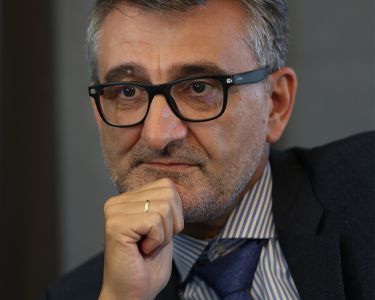
Dr. Jean–Philippe Gammel
Director for Talent Management & Diversity – DG Human Resources at European Commission, Brussels
Jean-Philippe Gammel has been an official of the European Commission since 2008. He has held various positions, including as a member of Cabinet of the Commissioner for Education, Culture, Youth and Sports. He is currently advising the Director for Talent Management and Diversity. He has been leading the office of Vladimir Šucha, when Vladimir was the Director-General of the Joint Research Centre. They also co-authored a report on the longer-term impacts of Artificial Intelligence published in April 2021. Before joining the European Commission, Jean-Philippe was the manager of several technical assistance programmes for South-East Europe and Russia in the Council of Europe. He has also been a visiting professor on European affairs in many universities including Sciences Po Strasbourg, the Centre Européen Universitaire or the Ecole Nationale d’Administration (ENA).
